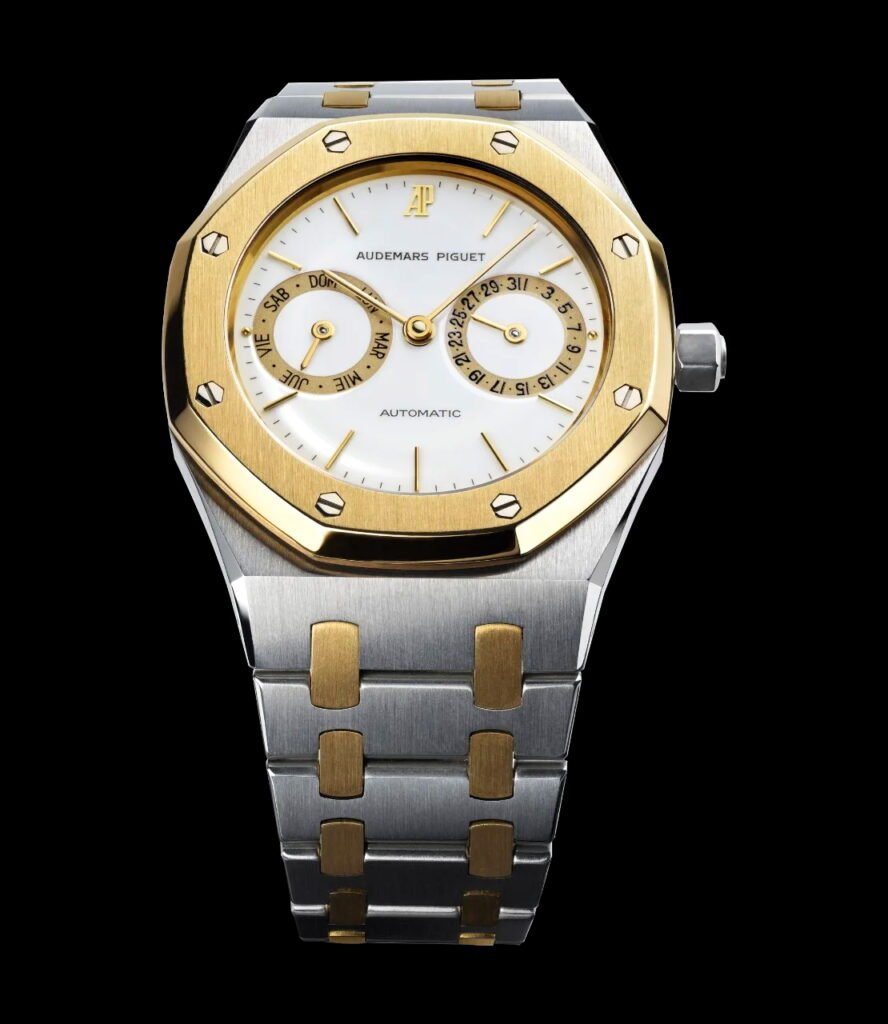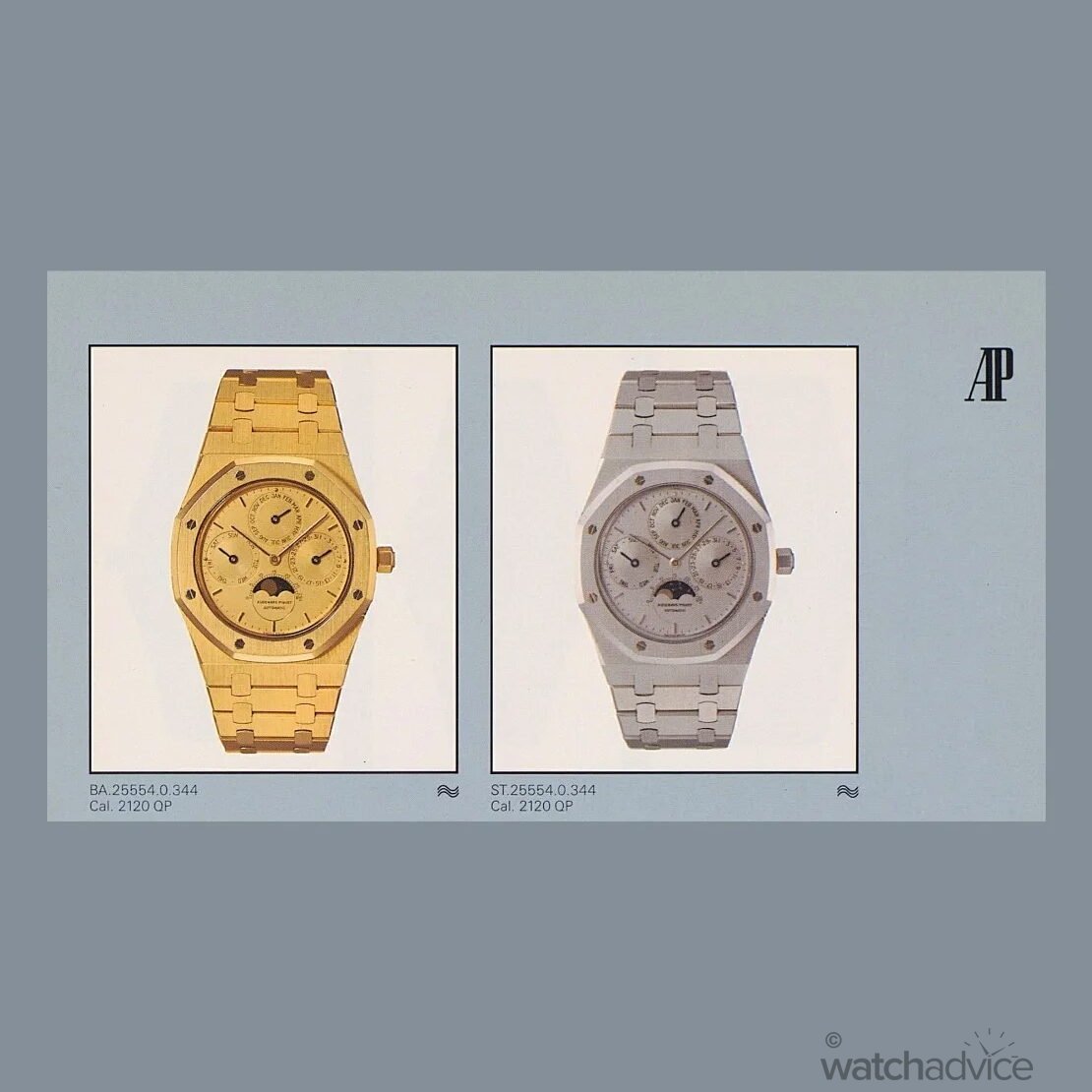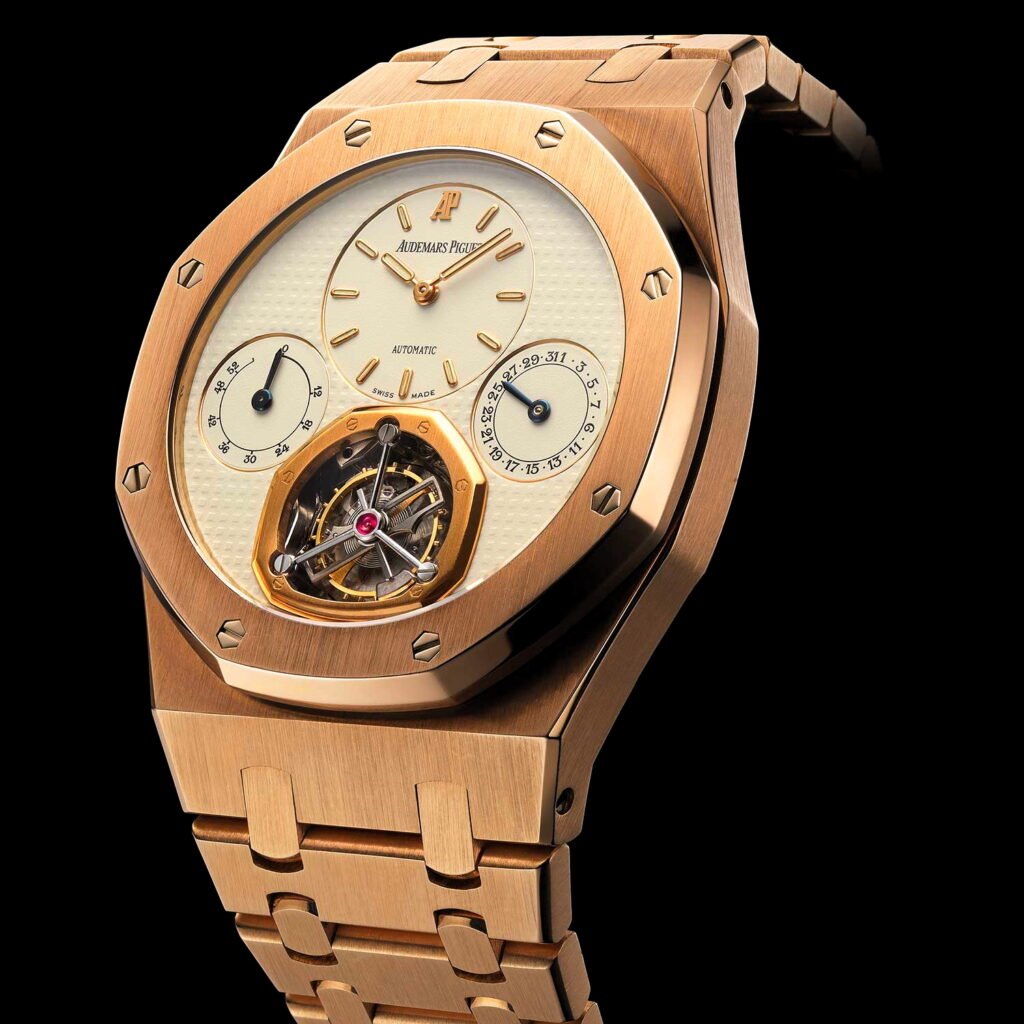In part two of Legacy of Iconic Watch Designs—Audemars Piguet Royal Oak, we examine how the Royal Oak has evolved over the years to become one of the most sought-after watches in the market today.
Audemars Piguet’s Royal Oak is an icon in and outside of the world of watches. In part one of The Legacy of Iconic Watch Designs: Audemars Piguet Royal Oak, we looked at the brand’s early years and how it gained recognition for creating complex timepieces.
Related Reading: The Legacy Of Iconic Watch Designs: Audemars Piguet Royal Oak – Part One
While Audemars Piguet established itself in the world of horology through its innovative creations, such as being one of the first to create a minute repeater, it really put itself on the radar after the launch of the Royal Oak. The story of Royal Oak’s inception is quite the tale as well (which you can read in part one!), as the design concept for the watch was thought overnight, the day before the 1970 Basel Fair.

The bravery of two gentlemen, Georges Folay and Gerald Genta, weathered the storm of the Quartz crisis to create one of the most iconic timepieces in watchmaking history. In Part One of this story, we looked in-depth at how the Royal Oak came to be and what inspired its design. We also examined the finer details (such as the tapered bracelet design) that went into creating this iconic masterpiece.
In Part Two, we will examine the evolution of the Royal Oak and how the timepiece retains its core signature design while keeping up with modern horology by using new materials, different complications, and concept designs.
The Royal Oak Timeline: A Journey Through Design Eras
When the Royal Oak was first released in 1972, it had a unique design that broke away from the traditional aesthetics of luxury timepieces at the time. It was rare to see a stainless steel sports watch, and almost unheard of in Royal Oak’s design language of a tapisserie dial with an octagonal bezel on the tapered integrated bracelet. All these elements came together to set a new standard for high-end sports watches, which served to establish Audemars Piguet as a forward-thinking brand willing to step outside the boundaries.
Since its creation, exactly 50 years ago, the Royal Oak has undergone numerous evolutions, incorporating various complications and different materials into the signature design to not only stay with modern times but also adhere to a variety of clientele.
Early versions of the Royal Oak model were mainly centred around the time-only models, while the women’s Royal Oak model was also released. However, almost a decade later, Audemars Piguet started incorporating gem settings for a more luxurious finish while creating new additions with different complications, such as moon phases, chronographs, perpetual calendars, and tourbillons. Audemars Piguet also released the Royal Oak Offshore, a design variant of the Royal Oak that pushed the boundaries further by offering a larger and more robust version of the original Royal Oak.

Audemars Piguet’s use of different materials also plays a significant part in the evolution of the Royal Oak. The first Royal Oak (reference 5402ST) was presented in stainless steel; however, as time went by, later versions of the Royal Oak incorporated a variety of materials, from gold, platinum, and titanium to ceramic. The use of these different materials on the Royal Oak not only served to enhance the aesthetic of the timepiece but also to showcase that the brand isn’t afraid to explore new frontiers in watchmaking. The use of forged carbon and ceramic on the watch gave it more durability while upgrading the model for more modern clientele.
With the aesthetics of the Royal Oak changing over the years with different materials and complications, Royal Oak Offshore and even concept watches, Audemars Piguet has constantly evolved the movement to suit these various designs. The brand has produced an extra-thin version of the original Royal Oak with a slimmer movement for those who prefer Royal Oak on the thinner side. This continuous evolution of the Royal Oak, whether it’s through design innovation, the use of different and new materials, or technical advancements in the movement, ensures that the Royal Oak remains at the forefront in the world of horology, appealing to both long-time watch enthusiasts and new-watch lovers alike.
1976- Birth of Women’s Royal Oak (II)
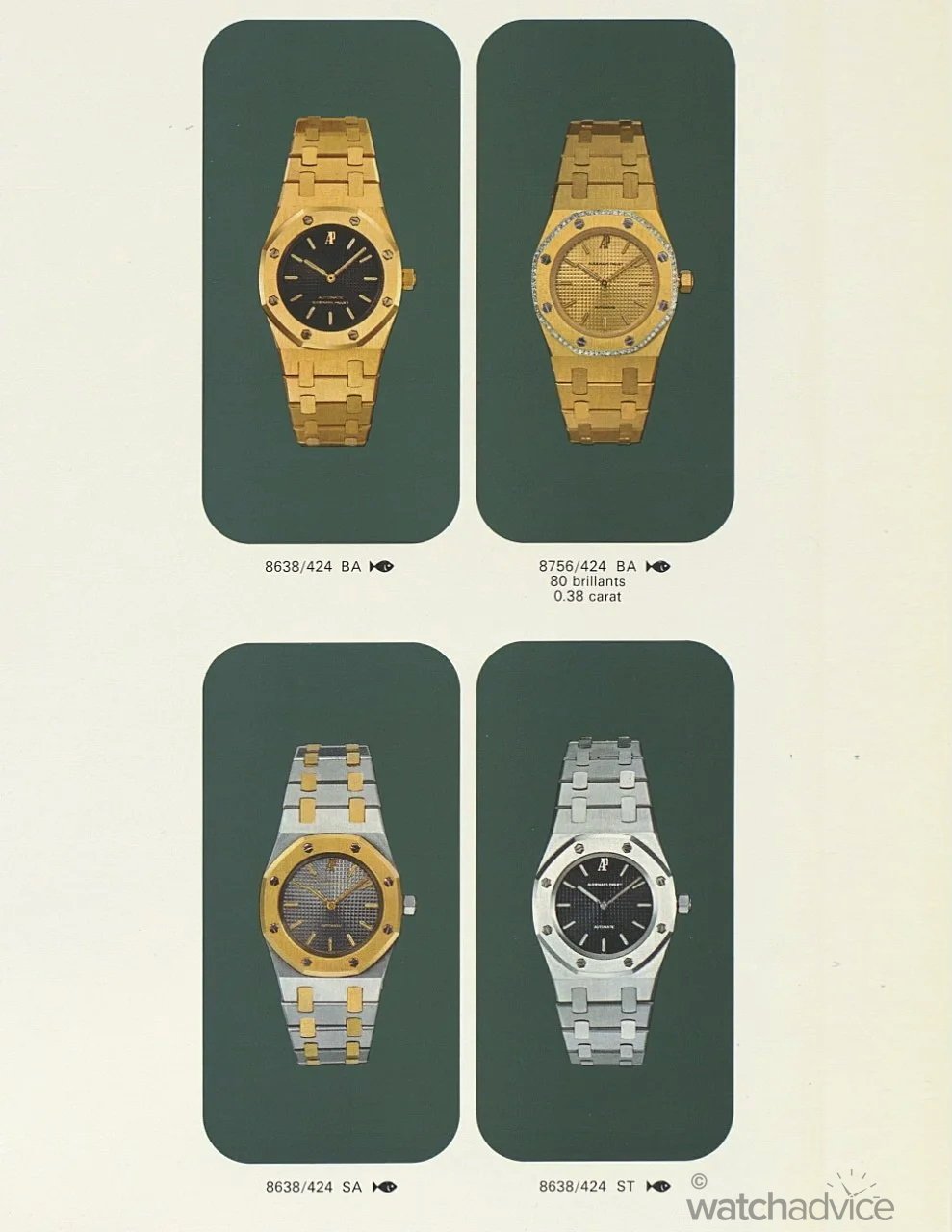
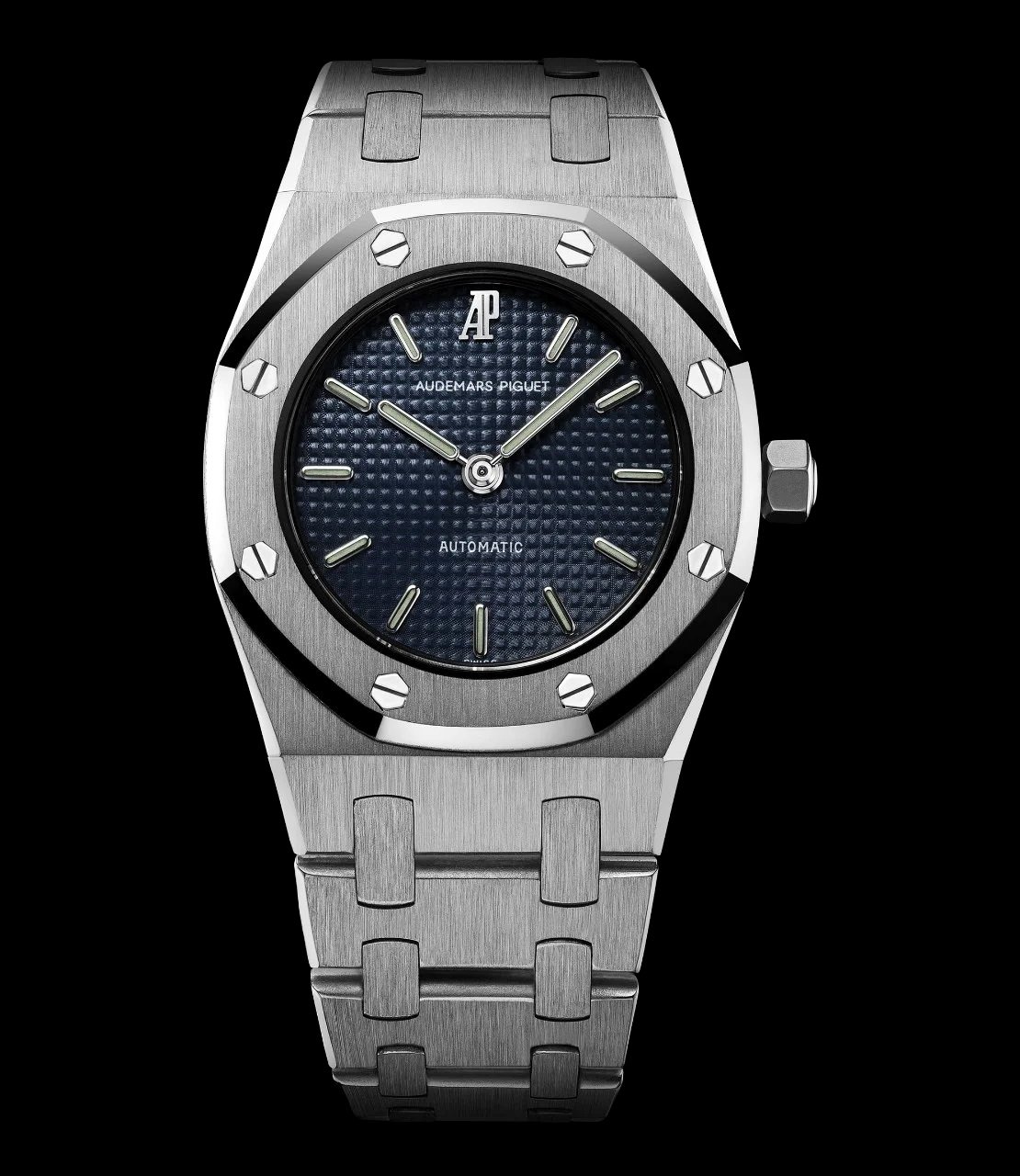
After the release of the first Royal Oak in stainless steel in 1972, Audemars Piguet presented the second version of the timepiece, this time marketed towards the female clientele. The birth of the first woman’s Royal Oak, named the Royal Oak II (reference 8638), was for the first time presented to the buyer in two different material versions: tow-tone and yellow gold. In 1978, the brand presented the Royal Oak II in white gold.
The Royal Oak II came in a smaller 29mm diameter case. None of the core features of the watch changed, with only the movement needing to be changed to a small self-winding Calibre 2062 (Rayville – LeCoultre blank) to suit the new measurements of the watch. Audemars Piguet states that the timepiece sold approximately 3,889 units starting from 1976, with sales continuing until 1990.
1977 – Royal Oak III
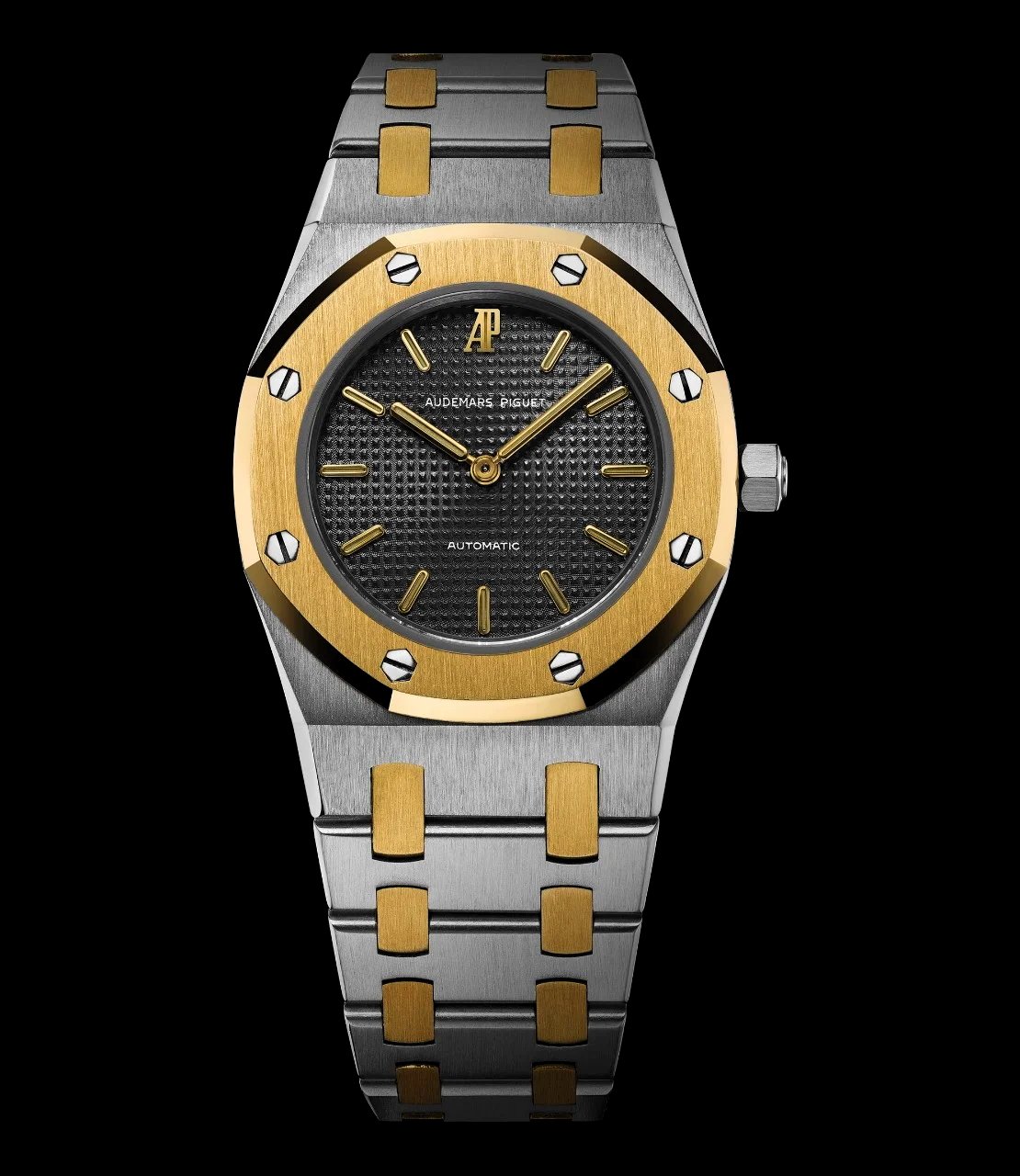
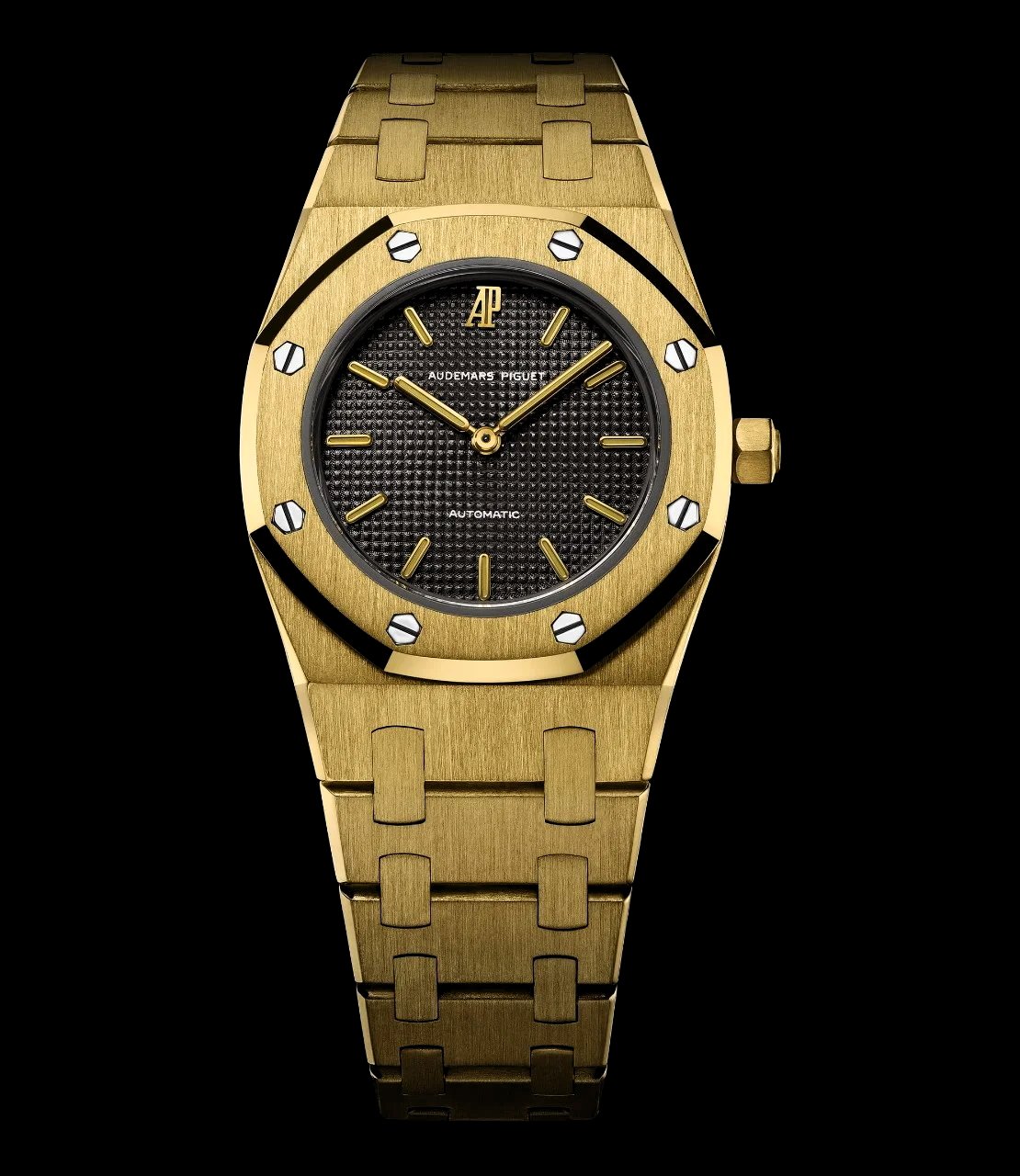
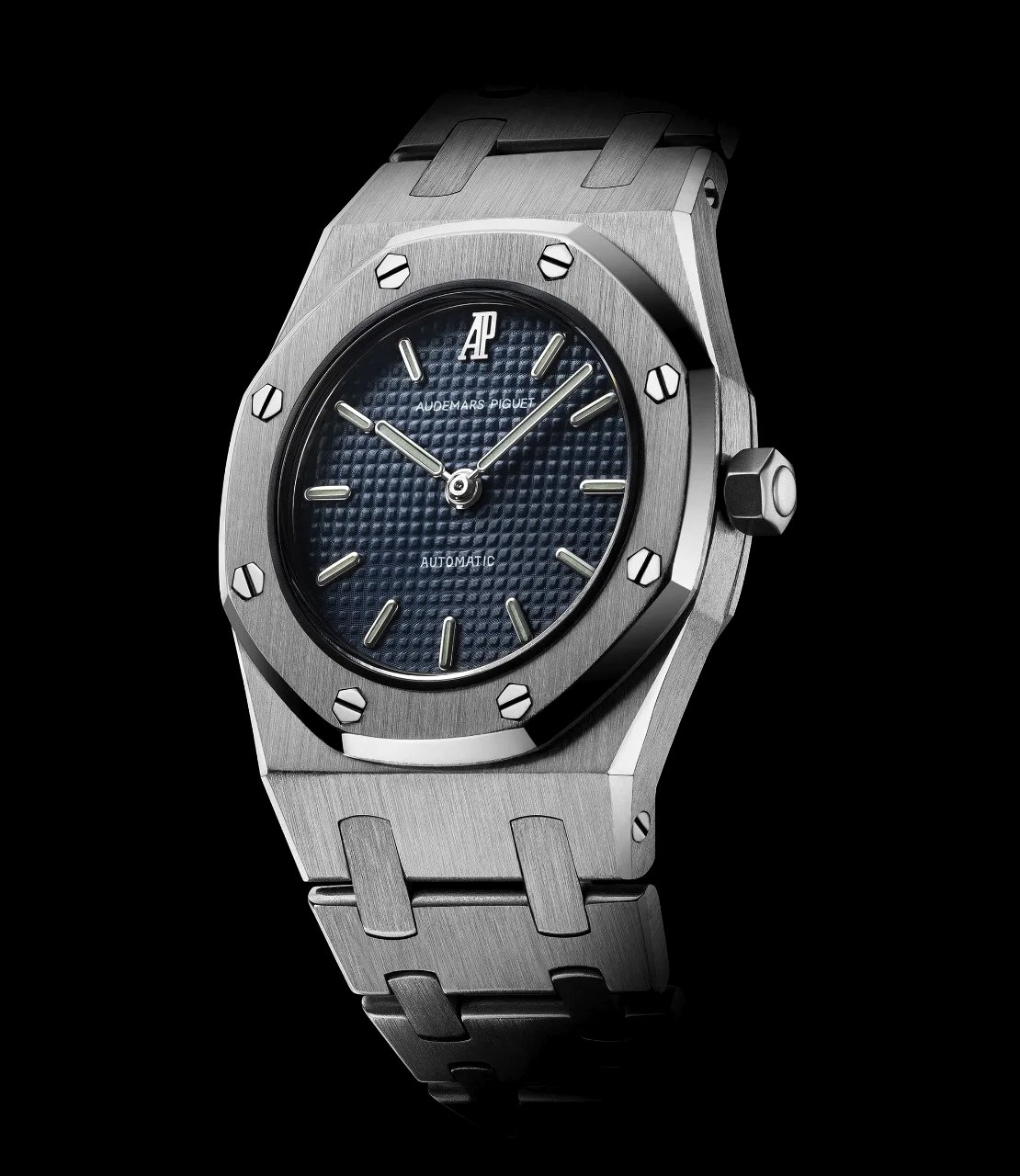
The Royal Oak III, as the name suggests, was the third evolution of the Royal Oak. The timepiece was designed by Jacqueline Dimier and was presented as Royal Oak reference 4100 in 1977. This reference was the first Royal Oak to feature a centre seconds hand! With this slightly tweaked design, this men’s model was also slimmed down to a size of 35mm diameter, to better cater for the clientele that considered the original Royal Oak 5402ST (39mm) to large.
Building on the success of the woman’s Royal Oak II (ref. 8638), this latest men’s version was also presented in three materials: steel, two-tone and 18-carat yellow gold. Audemars Piguet states that more than 8,400 models of Royal Oak III were sold between 1997 and 2002.
1979 – First Royal Oak to be Gemset
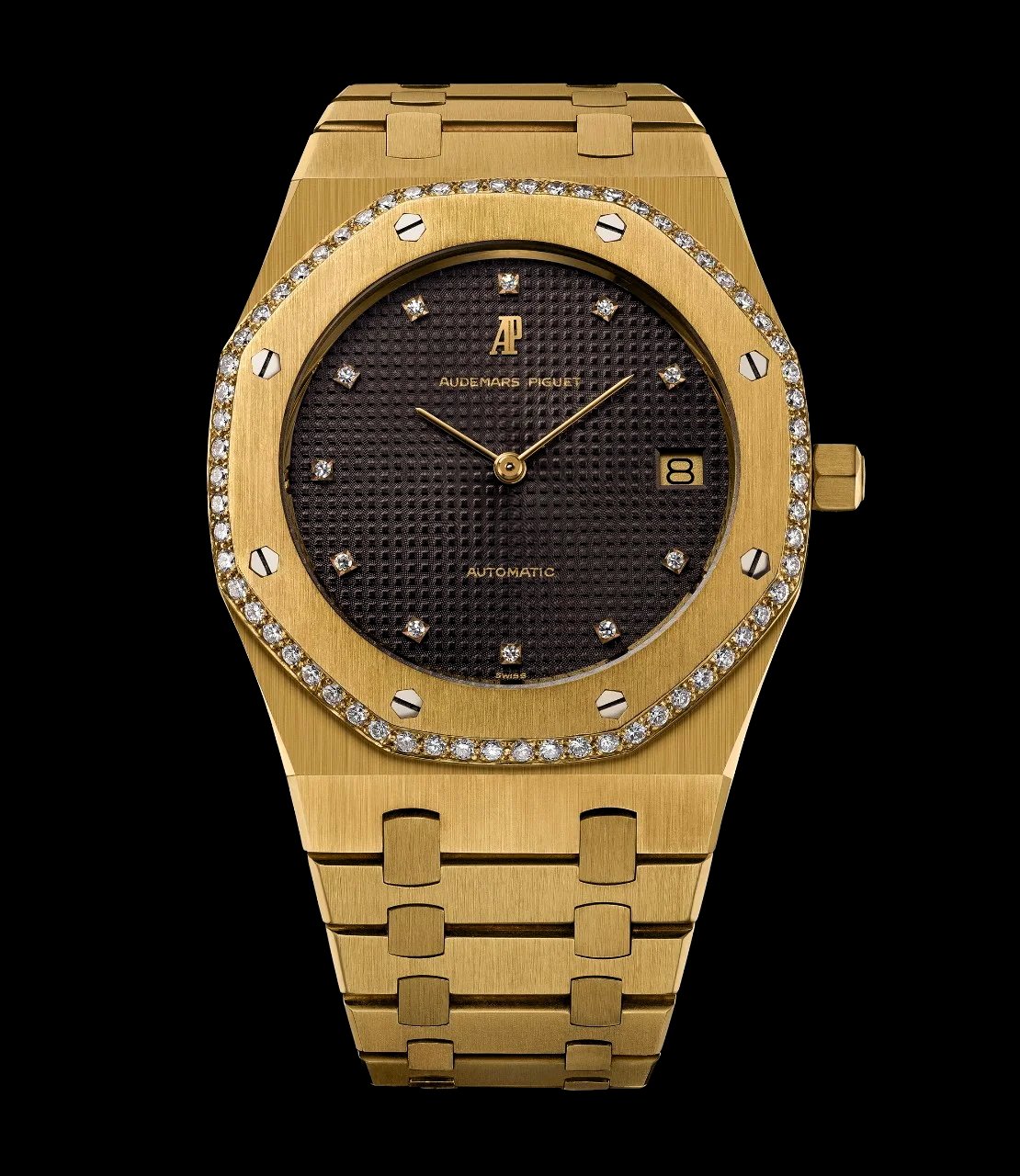
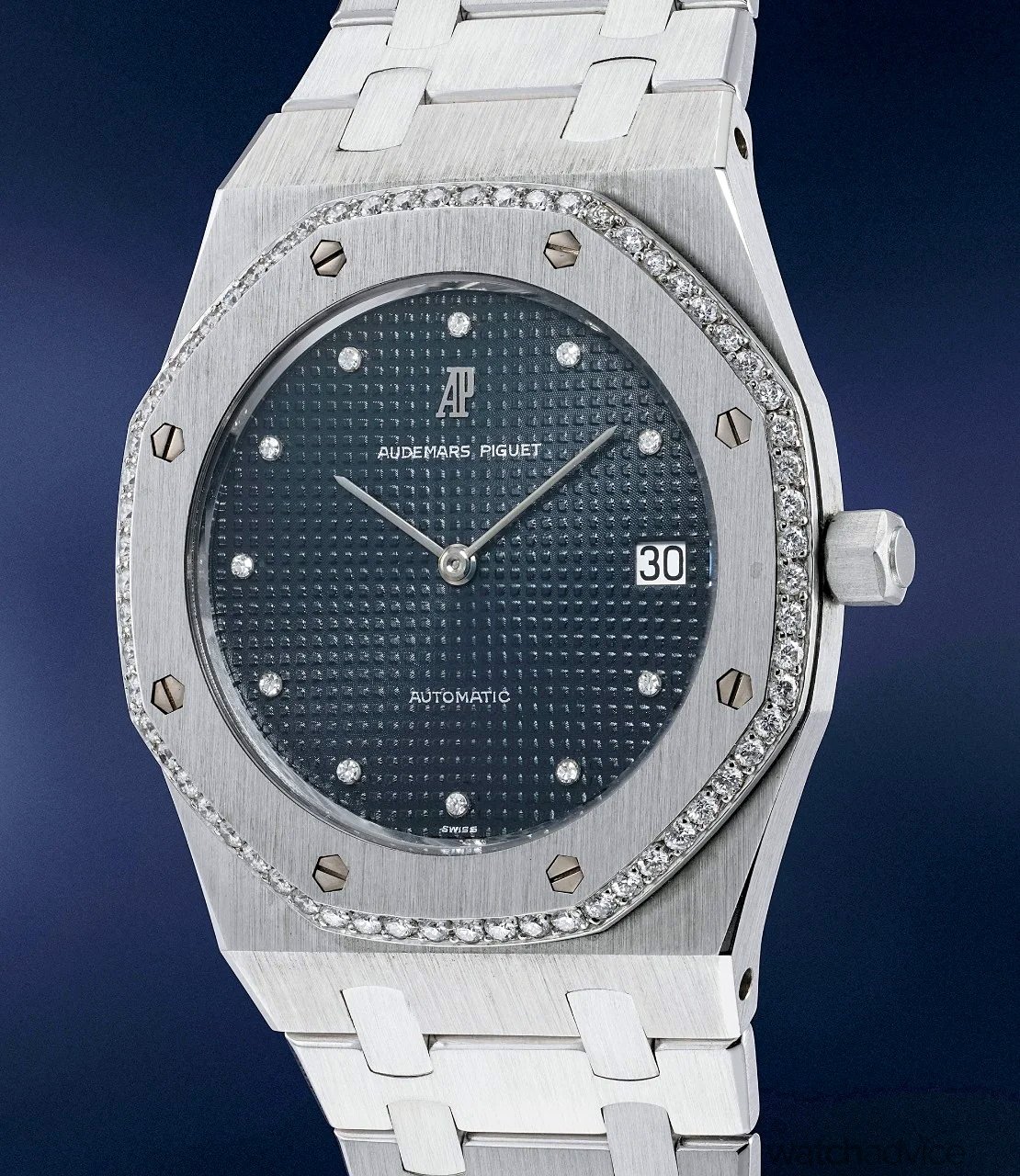
In 1979, Audemars Piguet presented the first Royal Oak gem-set timepieces. Between 1979 and 1991, the brand started transforming 19 examples of the first Royal Oak ref. 5402 by gem-setting the bezel rim. Audemars Piguet placed 8 diamonds per bezel size, totalling 64 diamonds around the bezel. The new reference for these gem sets was Royal Oak 4187.
Audemars Piguet presented the gem-set Royal Oaks in either white gold or 18-carat yellow gold. The brand states that “only nine examples of Model 4187 in yellow gold appear in the Audemars Piguet registers. The watches were sold between 1980 and 1985. As with the white gold variation, the German market accounted for more than half of the sales.”
1982 – First Royal Oak Haute Joaillerie
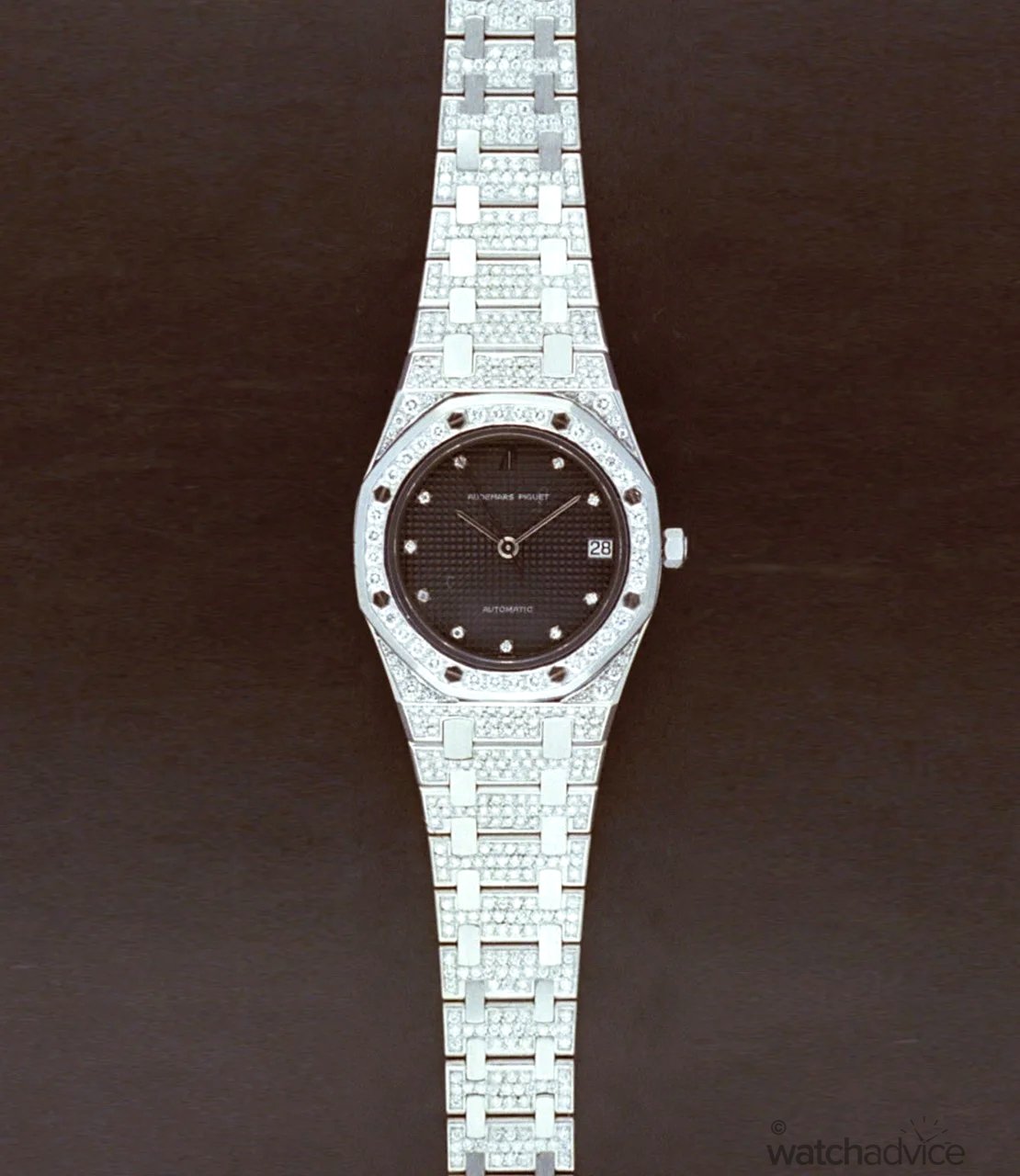
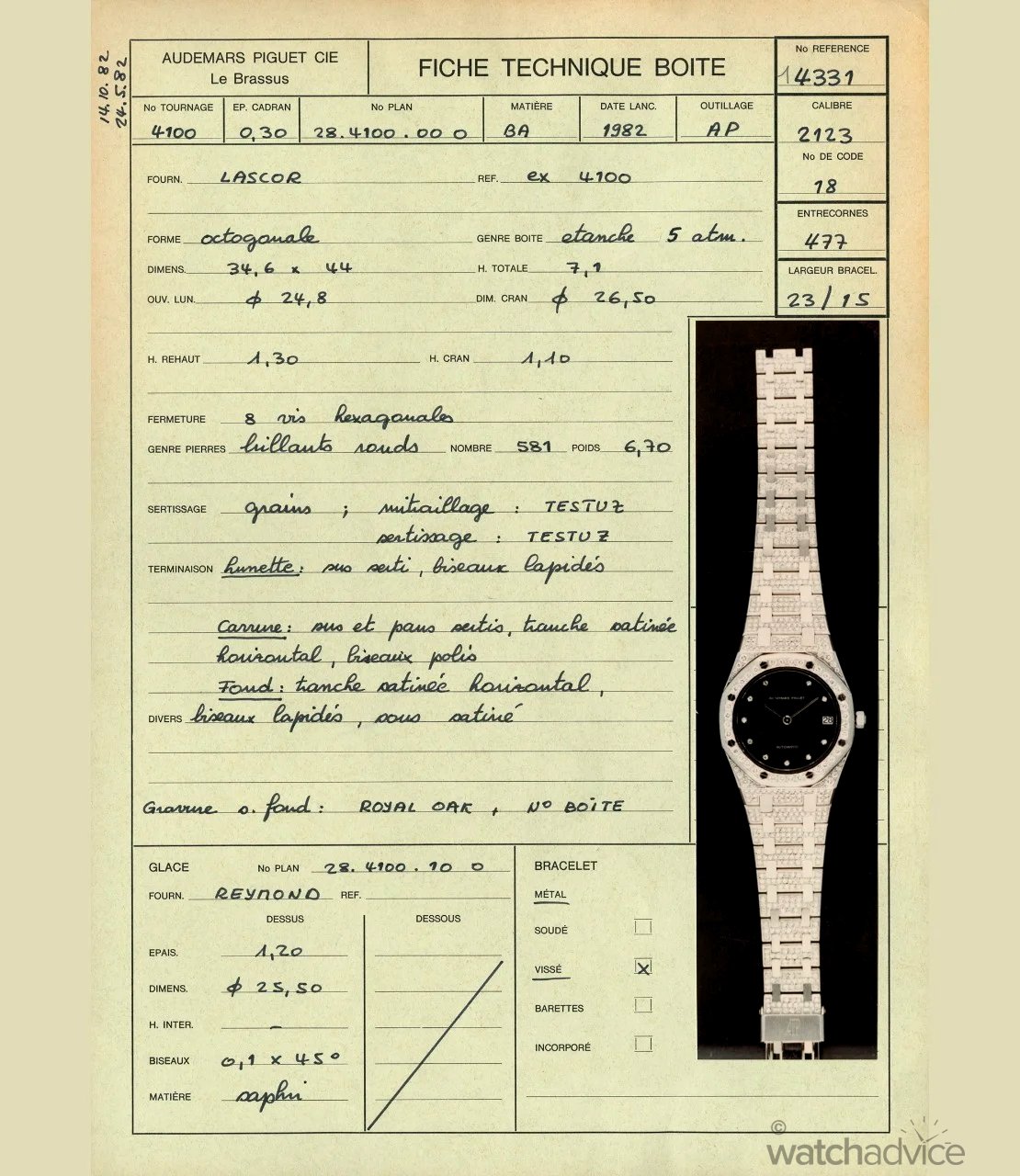
The First Royal Oak to be fully gem-set was presented shortly after the release of Royal Oak ref. 4187 in 1982. This timepiece, named reference 4331m, had a top of its bezel adorned with 32 brilliant-cut diamonds, while the case middle featured 80 brilliant-cut diamonds. The bracelet was also adorned with diamonds, with each bracelet link having three horizontal rows that encased diamonds. Together, the bracelet featured 460 brilliant-cut diamonds. With the 10 diamonds on the dial, the Royal Oak ref. 4331 had a total of 584 brilliant-cut diamonds!
Audemars Piguet states that “To date, only two Model 4331 watches have been identified in the Audemars Piguet records. The first, in yellow gold, was sold in Singapore on April 9, 1982. The second, in white gold, was delivered to Abu Dhabi the following year. Their small Royal Oak numbers belong to Model 4100.”
1983 – Royal Oak Receives Its First Complication
The years 1983 and 1984 were major milestones for the Royal Oak in that this is when we see the first complications being fitted into the iconic timepiece. The first complication for the Royal Oak was neither a chronograph nor a perpetual calendar, even though by this point, Audemars Piguet was a master of the two complications. It was rather a “small complication”, whereby two counters indicate the day and date with a hand. The appearance of this model was nicknamed the “owl” at the time due to the large appearance of these sub-counters.
This model, released in 1983, was presented in a 36mm case size and was named ref. 5572. The brand states that “more than 600 of these watches had already been delivered; one may safely assume that it corresponded to extremely strong market demand. From the very first year, several variants were offered in steel, yellow gold, two-tone (steel and yellow gold) and even white gold with white, black, guilloché or smooth dials.”
1984 – First Royal Oak Day-Date Moon Phase
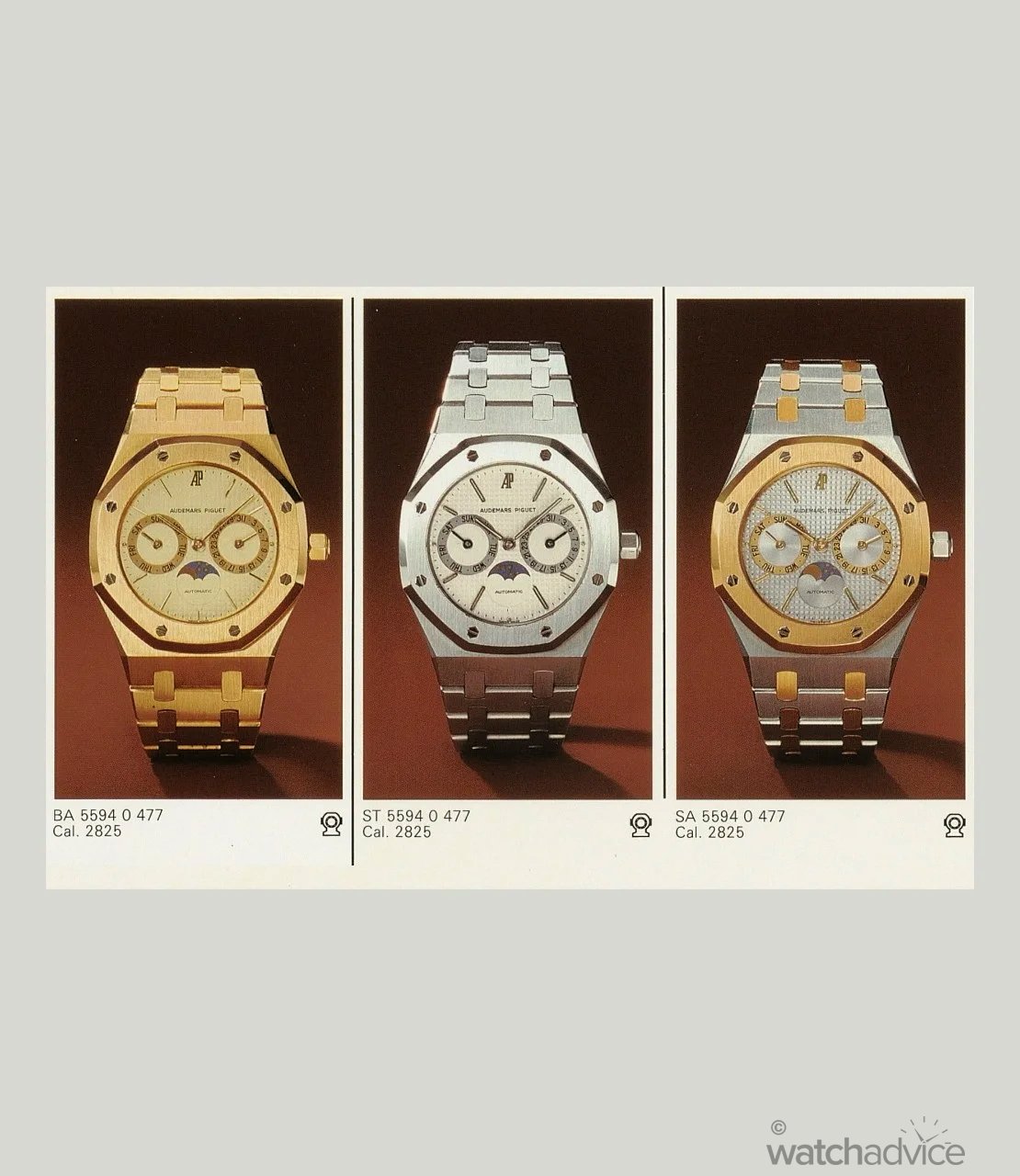
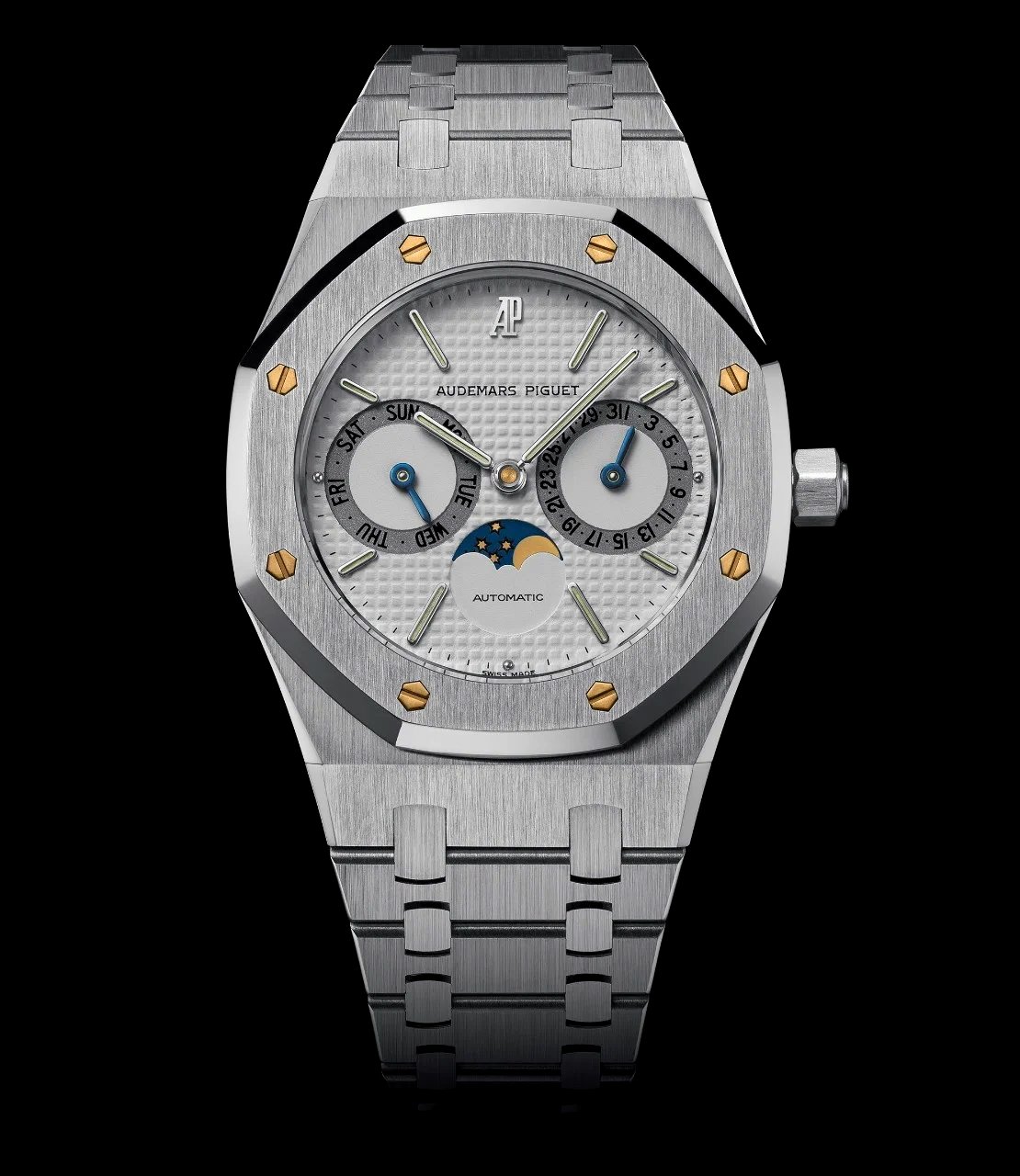
Following the success of the Royal Oak Day-Date, Audemars Piguet presented the next evolution of the complication the following year: a moon-phase aperture on the dial. The moon phase sits between the day-date complications at 6 o’clock, providing a much better-balanced aesthetic look.
This moon phase edition was named ref. 25594, and upon its release, it was an immediate success. Understandably, if this model were released today, I would see it having the same success! A total of 333 timepieces were sold in 1984, with a further 600 being sold in 1985. However, as impressive as this was, what really makes this model stand out in Audemars Piguet’s history is the fact that ref. 25594 remained in the brand’s catalogue for over 20 years, from 1985 to 2006!
1984 – First Royal Oak to feature Perpetual Calendar Complication
At the same time Audemars Piguet was designing the Royal Oak Day-Date and the Day-Date Moon Phase, the brand was also creating the first-ever Royal Oak Perpetual Calendar. On April 5th, 1984, Audemars Piguet presented the first Royal Oak Perpetual Calendar on the opening day of the Basel Fair. The calendar was initially named reference 5554 but was later renamed reference 25554. The first recorded model of the Royal Oak Perpetual Calendar being delivered to a customer was in December 1984, with the model being in yellow gold.
Audemars Piguet states that they did take longer than expected to finalise the design and construction of the Royal Oak Perpetual Calendar as “the watchmakers had set themselves the objective of fitting Calibre 2120/2800 (3.95 mm thick) into the same extra-thin case as the Royal Oak 5402, which until then housed Calibre 2121 (3.05 mm). To achieve this, the bezel was slightly raised, the sapphire crystal was trimmed, and three places were created to accommodate the three calendar correctors. As a result, Model 2554 is only 7.5 mm, thick, i.e. barely 0.4 mm thicker than Model 5402.”
The brand sold 270 models of the Royal Oak Perpetual Calendar between 1984 and 1992 in steel and yellow gold, with one reference being in platinum (possibly a custom order, as it was for a client in Germany).
1986 – Royal Oak Perpetual Calendar Openworked!

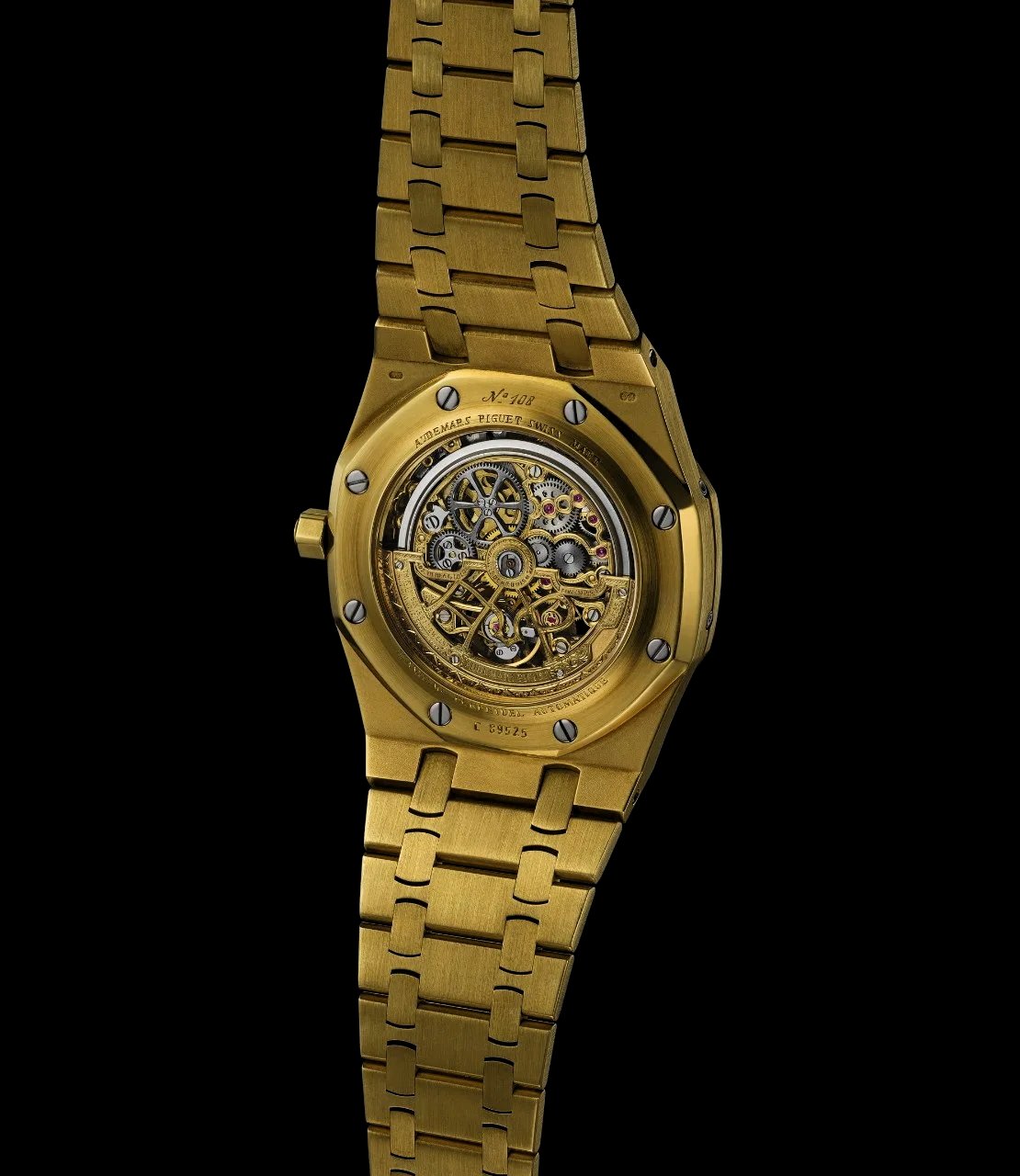
Two years after the release of the Royal Oak Perpetual Calendar, Audemars Piguet released one of my favourite timepieces yet from the brand, the Perpetual Calendar Openworked! Taking the name ref. 25636, the Royal Oak Perpetual Calendar Openworked was born in a workshop that has played a very special role in the history of the Manufacture Audemars Piguet.
The story goes that “Régis Meylan was the foreman from 1974 to 2018 at the Manufacture Audemars Piguet. He recalls that it was here that the art of openworking was revitalised in 1975, at the dawn of the quartz crisis. It was also here that the legendary Calibre 2120/2800 was created in 1978, and the first Royal Oak perpetual calendar watches were born in 1984.”
It’s recalled that the openwork design on the Royal Oak Perpetual Calendar from 1984 required more than a month. Model 25636 lasted for 10 years in production, with the materials used for case construction evolving over this period of time. The Royal Oak Perpetual Calendar Openworked was presented in steel, yellow gold, platinum, pink gold and two-tone variations including steel + platinum, pink gold + platinum and platinum + pink gold. With all these variations, the total sales of the Royal Oak Perpetual Calendar Openworked amounted to being 313 models from 1986 to 1997.
1986 – Royal Oak Perpetual Calendar Openworked Gemset
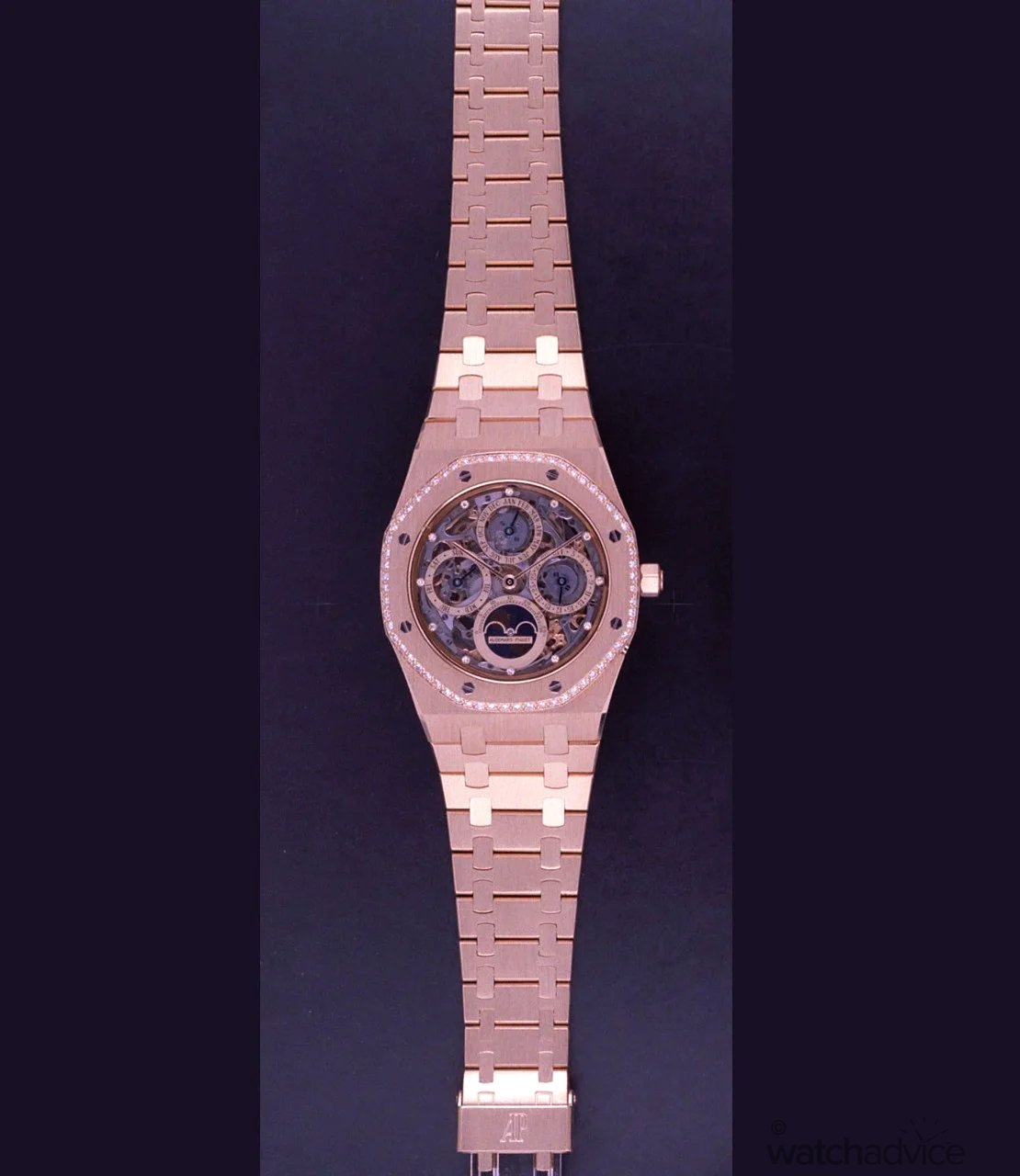
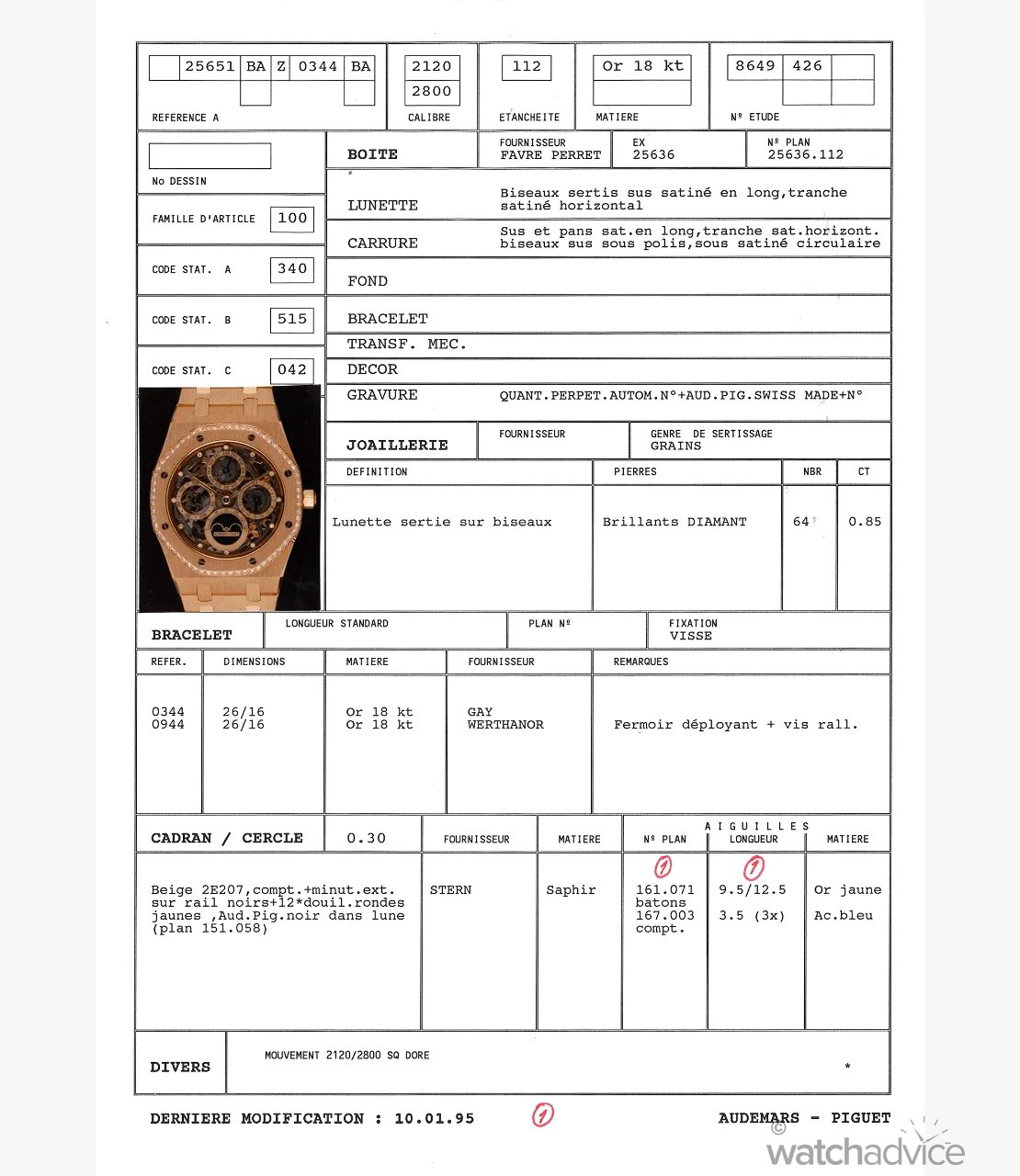
While gem-set timepieces became popular much later, the earliest record of the Royal Oak Perpetual Calendar Openworked with gemstones was in 1986, the same year the model was created. Audemars Piguet didn’t put this model into production, possibly because of low interest at the time.
Only one model of the Royal Oak Perpetual Calendar Openworked Gemset was created, with the name given as ref. 25651. This model, like Royal Oak ref. 4187, released in 1979, had a gem setting on the rim of the bezel, and the 12-hour indices were gems as well. The model was sold in yellow gold to an owner in Hong Kong.
1987 – Royal Oak Perpetual Calendar Ref. 25654
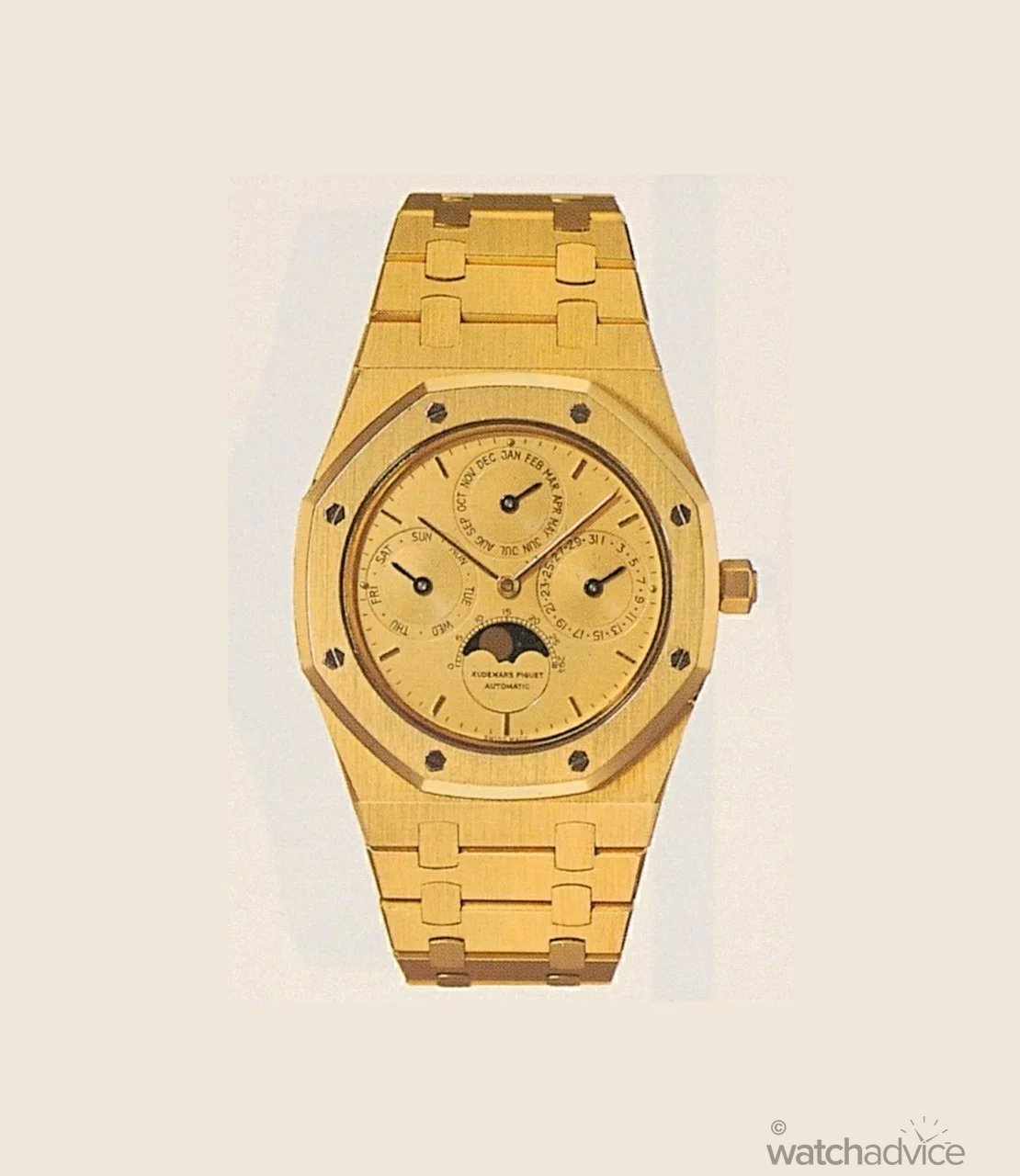

In 1987, Audemars Piguet reworked the case of the Royal Oak Perpetual Calendar to offer a timepiece with better water resistance. The case of this new Royal Oak Perpetual Calendar ref. 25654 had a slight increase from 7.5mm to 8.3mm to better its water resistance.
For almost 10 years, the Royal Oak Perpetual Calendar Ref. 25654 was at the heart of collection, with this reference being accounted for almost half of the perpetual calendar collection sales. This reference was taken out of Audemars Piguet’s catalogue in 1996, when the brand introduced its successor with a new updated movement (Calibre 2120/2801) that now featured a leap-year cycle indication. Sales of ref. 25654 from 1987 to 1998 totalled 851 models!
1989 – First Royal Oak Perpetual Calendar with Sapphire Caseback (Not Openworked)
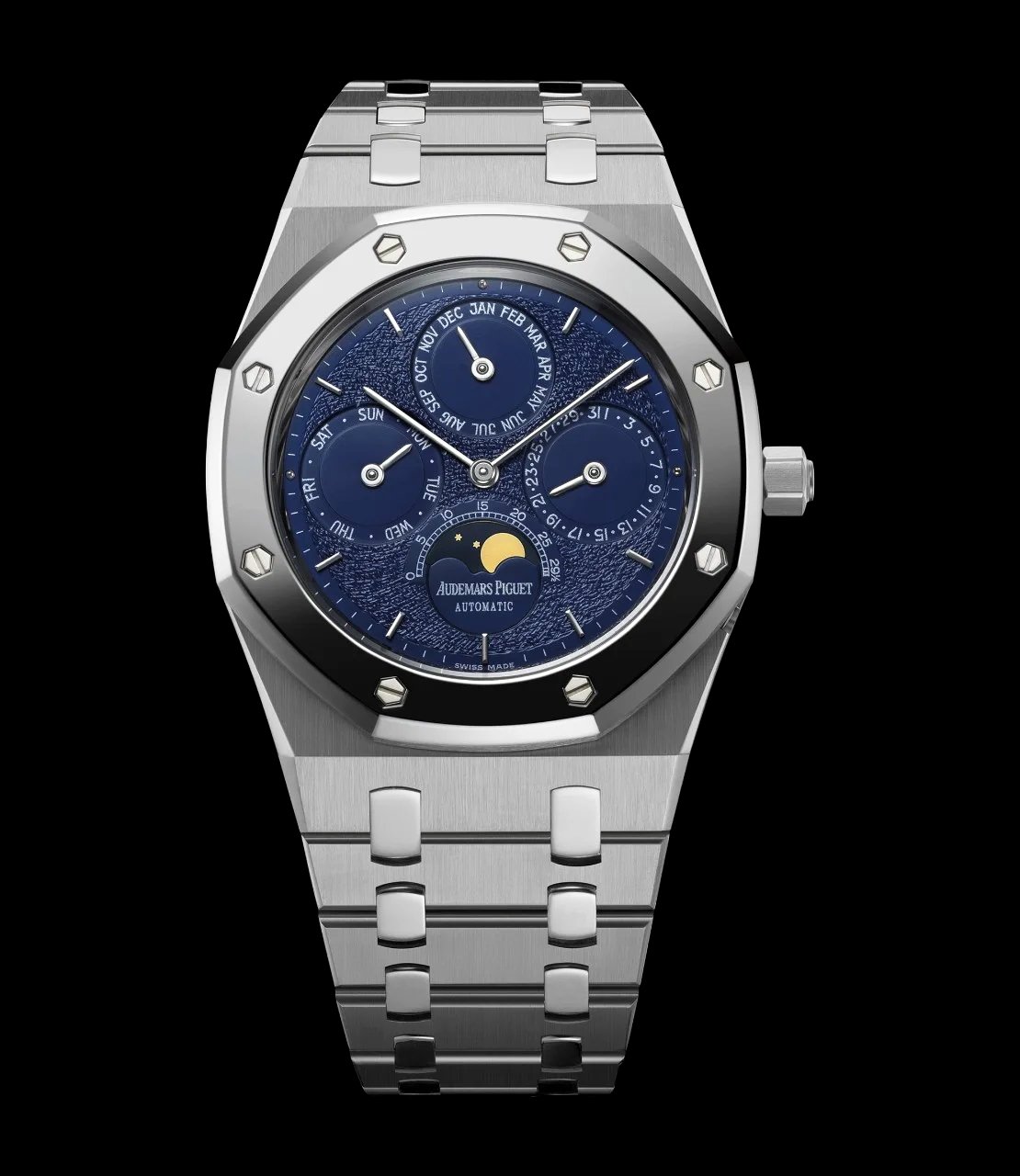
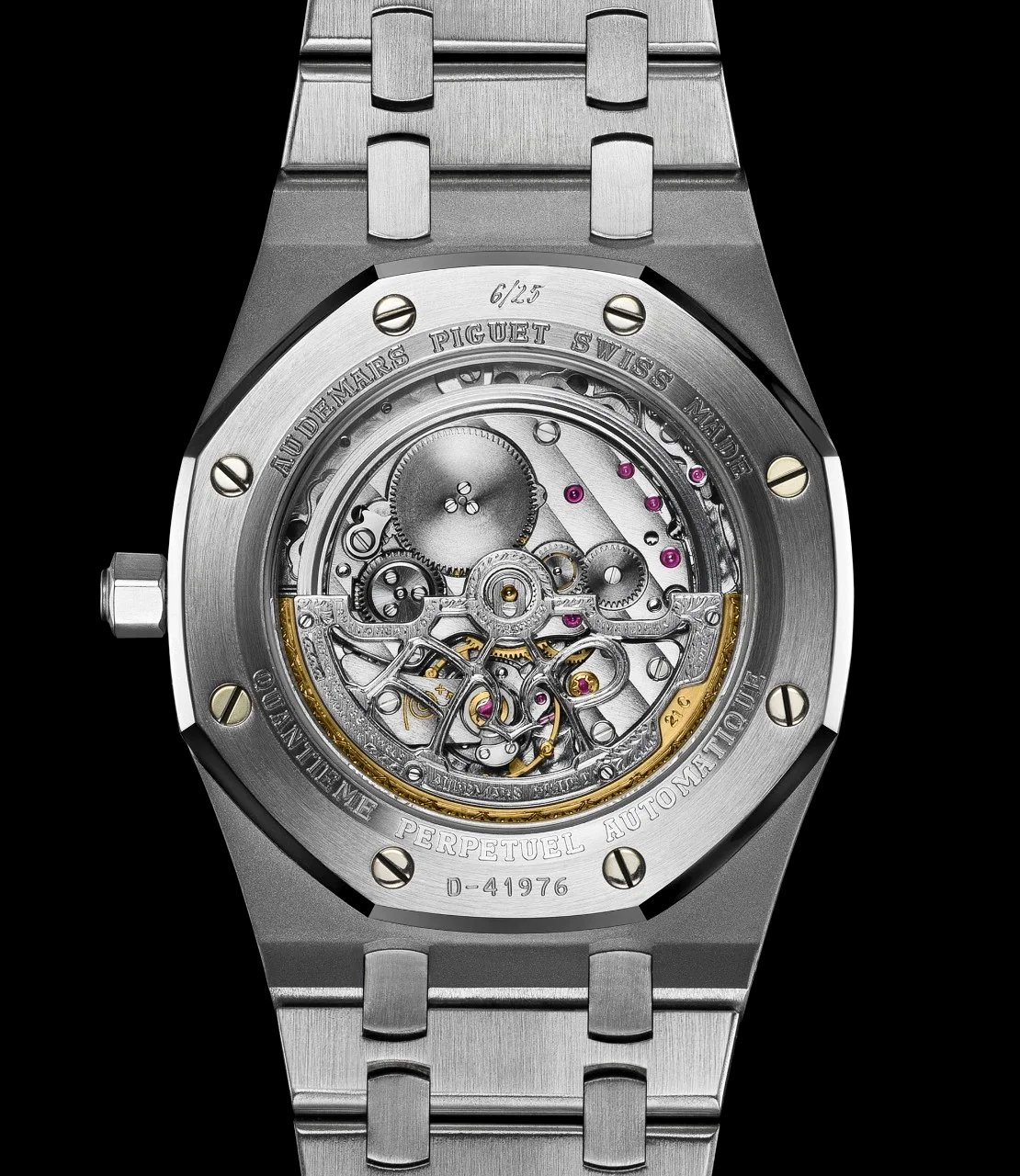
The first Royal Oak Perpetual Calendar to feature a see-through sapphire case back was reference 25686 released in 1989. Now, this isn’t to be confused with model 25636, released in 1986, as that was the open-worked version. Reference 25686 allowed buyers to enjoy the beauty of the complicated movement through the sapphire case back, without having to go down the skeletonised dial route.
The brand states that “distributed between 1989 and 1998, this model features a wide range of dial interpretations. It plays on their colour (gold, blue, salmon, pink, etc.) and varies their finish. In particular, this was the timepiece that introduced the guilloché pattern known as T21 Tapisserie into the world of the Royal Oak Perpetual Calendar, as well as the finely engraved “Tuscany blue“ dial and the mother-of-pearl dials.” Between 1989 and 1998, ref 25686 sold a total of 299 units.
1990 – First Royal Oak Travel Watch – Dual Time Ref. 25730ST
The very first Royal Oak designed by Audemars Piguet for travel was the Dual Time ref. 25730ST in 1990. With the advancement of the Royal Oak day-date and perpetual calendar complications, the brand branched out into creating dual-time travel watches for the collection.
The 36.5mm case Royal Oak Dual Time came with a date indicator at 2 o’clock, a secondary time at 6 o’clock, and a power reserve indicator at 9 o’clock. This was by far one of the more usable complications in the Royal Oak catalogue while still staying true to Gerald Genta’s signature design.
1992 – 20th Anniversary of Royal Oak Ref. 14802
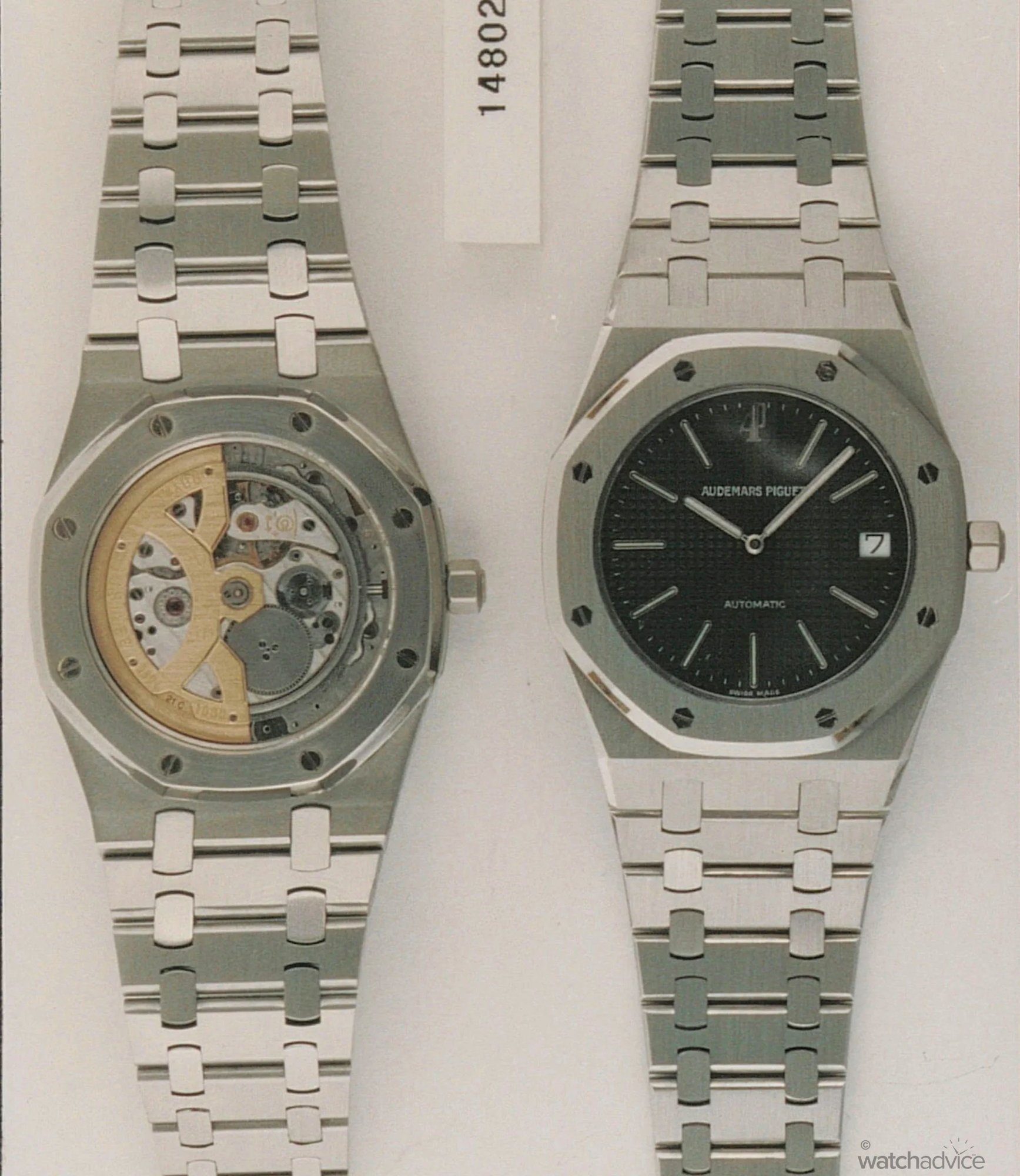
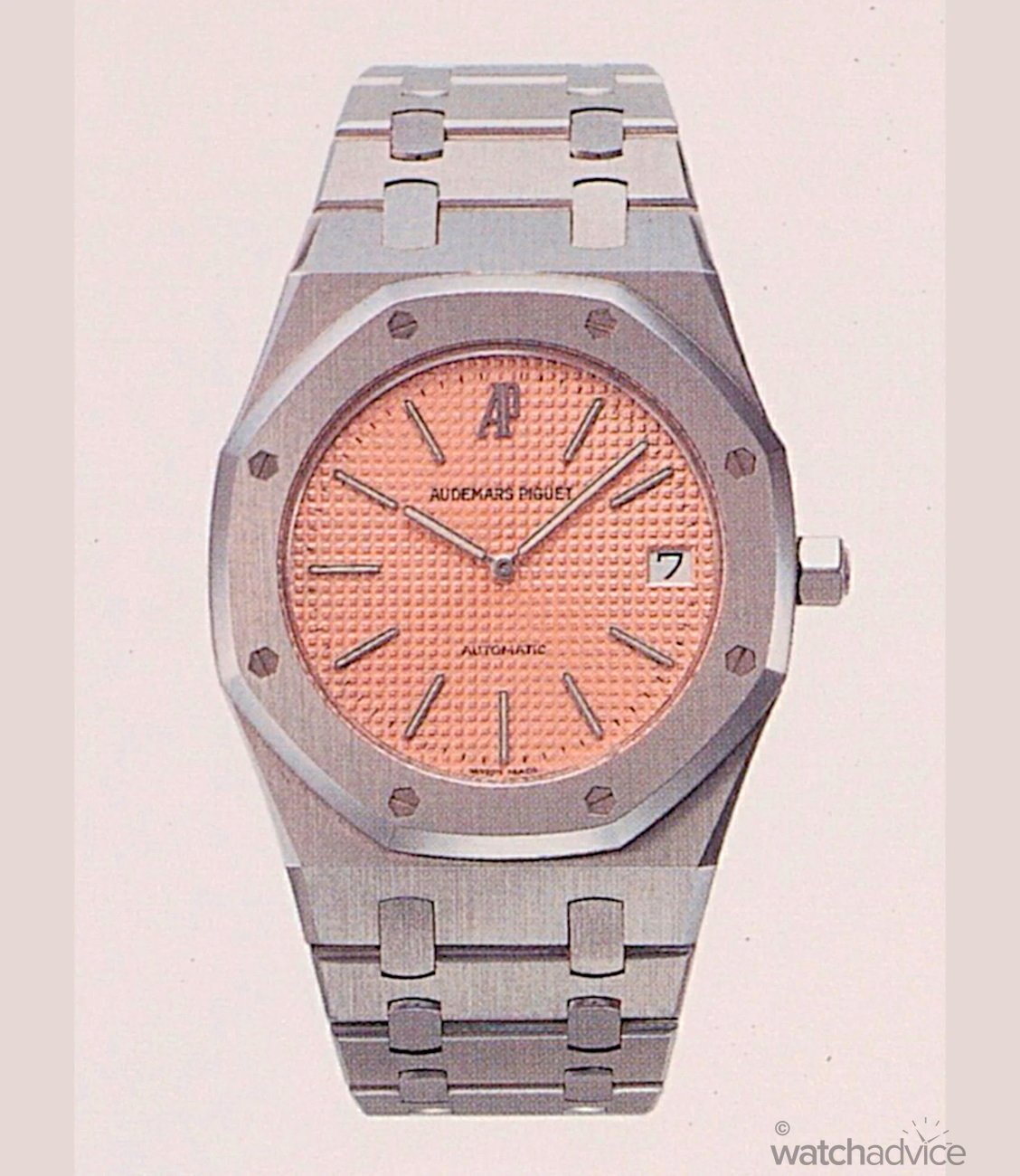
Audemars Piguet celebrated the 20th anniversary of the Royal Oak by releasing the Royal Oak Jubilee ref. 14802 in 1992. In the 20 years of Royal Oak production, the 39mm was the only ultra-thin model produced. This makes the Royal Oak Jubilee ref. 14802 the second “Jumbo” model in the brand’s Royal Oak history.
The timepiece stood out thanks to its three-part case construction, which also came with a transparent sapphire case back, which revealed the specially designed oscillating weight created for this 20th-anniversary jubilee model. This might also be the first time we see the Royal Oak being presented in a salmon pink-coloured dial. The brand states that a total of 998 units of ref. 14802 were sold between 1992 and 2002.
1993 – First Royal Oak Offshore


1993 marked a pivotal point in the history of Audemars Piguet’s Royal Oak, as this was when the first variant of the timepiece was presented. The Royal Oak Offshore ref. 25721 was born from the demand of the German market, who requested for a watch with “Offshore Spirit”. As Royal Oak’s 20th anniversary was the year before, this presented the perfect opportunity for Audemars Piguet to rejuvenate the Royal Oak with a new interpretation of the iconic timepiece.
However, model 25721’s release at the Basel Fair in April created quite a scandal. Audemars Piguet explains, “At that time, the average size of men’s watches was around 36 mm in diameter. With its 42 mm diameter and 14.05 mm thickness, the first Royal Oak Offshore was considered outrageous. Not to mention the huge water-resistance gasket protruding from its bezel. Its price is also shocking because its price tag was CHF 16,600, i.e. twice that of a classic Royal Oak. This was due, on the one hand, to the extreme complexity of its case, which is water-resistant to 100 metres; on the other, to its self-winding chronograph mechanism, which was a first in the Royal Oak family.”
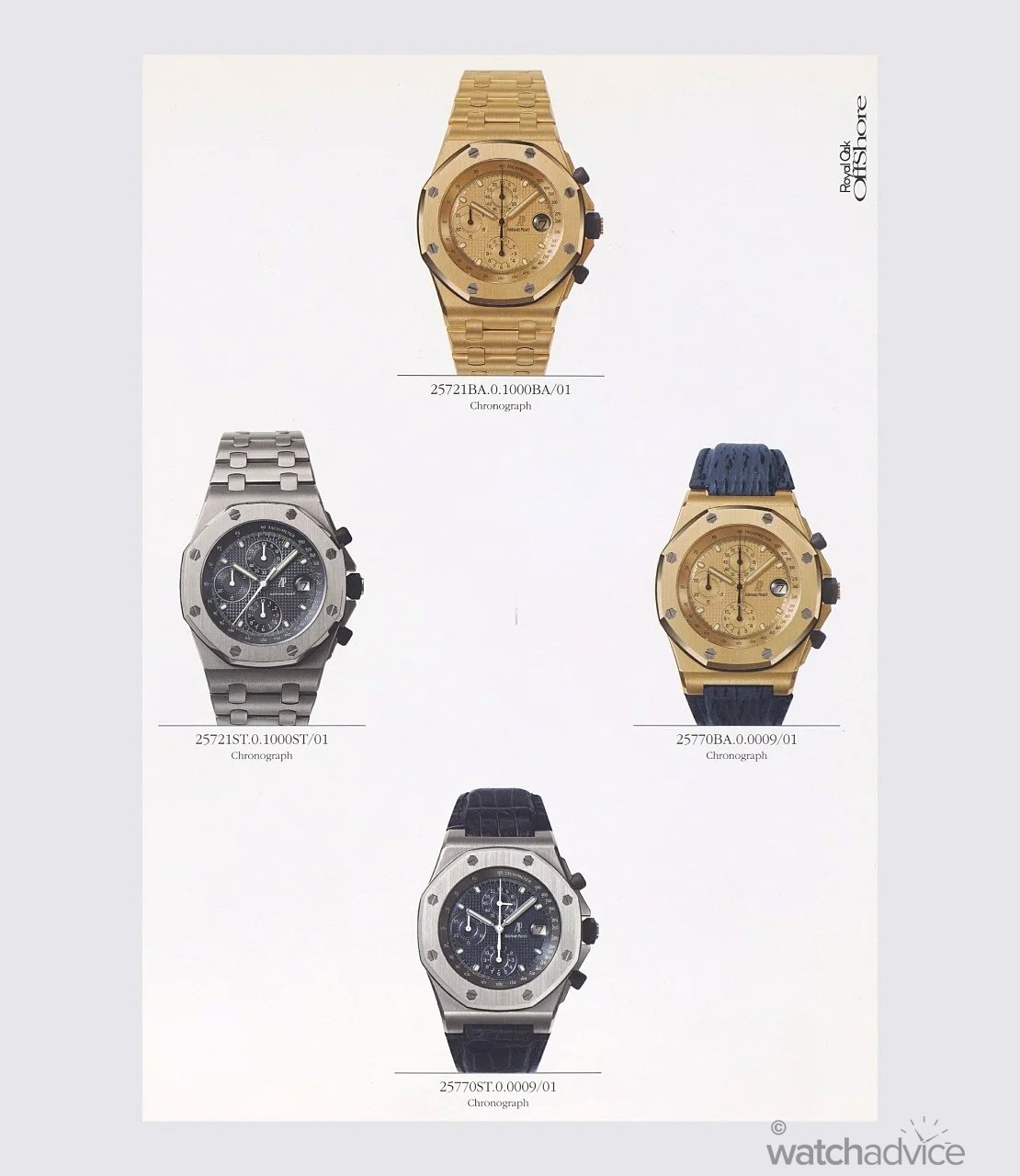

While the first Royal Oak Offshore had a turbulent ride in its first couple of years, as the timepiece won over only a handful of owners, it paved its way to success. In 1995, Audemars Piguet presented the Royal Oak in several precious material versions. In 1996, the Royal Oak Offshore was presented as a woman’s model in a 30mm case size and medium-sized 38mm models. 1996 was also the year in which the Royal Oak Offshore was presented in leather and rubber strap variants for the first time, something that is quite popular today. The leather strap Royal Oak Offshore timepieces came with the reference 25770.
To put into perspective Audemars Piguet’s bold decision to create the Offshore in a market that suited smaller timepieces, in the 2000s, the Royal Oak Offshore collection became so important that sales outnumbered those of the Royal Oak. This gradually led the entire watch industry to join the bandwagon of oversized watches, a segment for which it effectively blazed the trail. The Royal Oak Offshore ref. 25721 was marketed for 20 years, with sales amounting to 10,896 models (with different dials and different materials) over this period!
1996 – Royal Oak Offshore Complete Calendar 25807

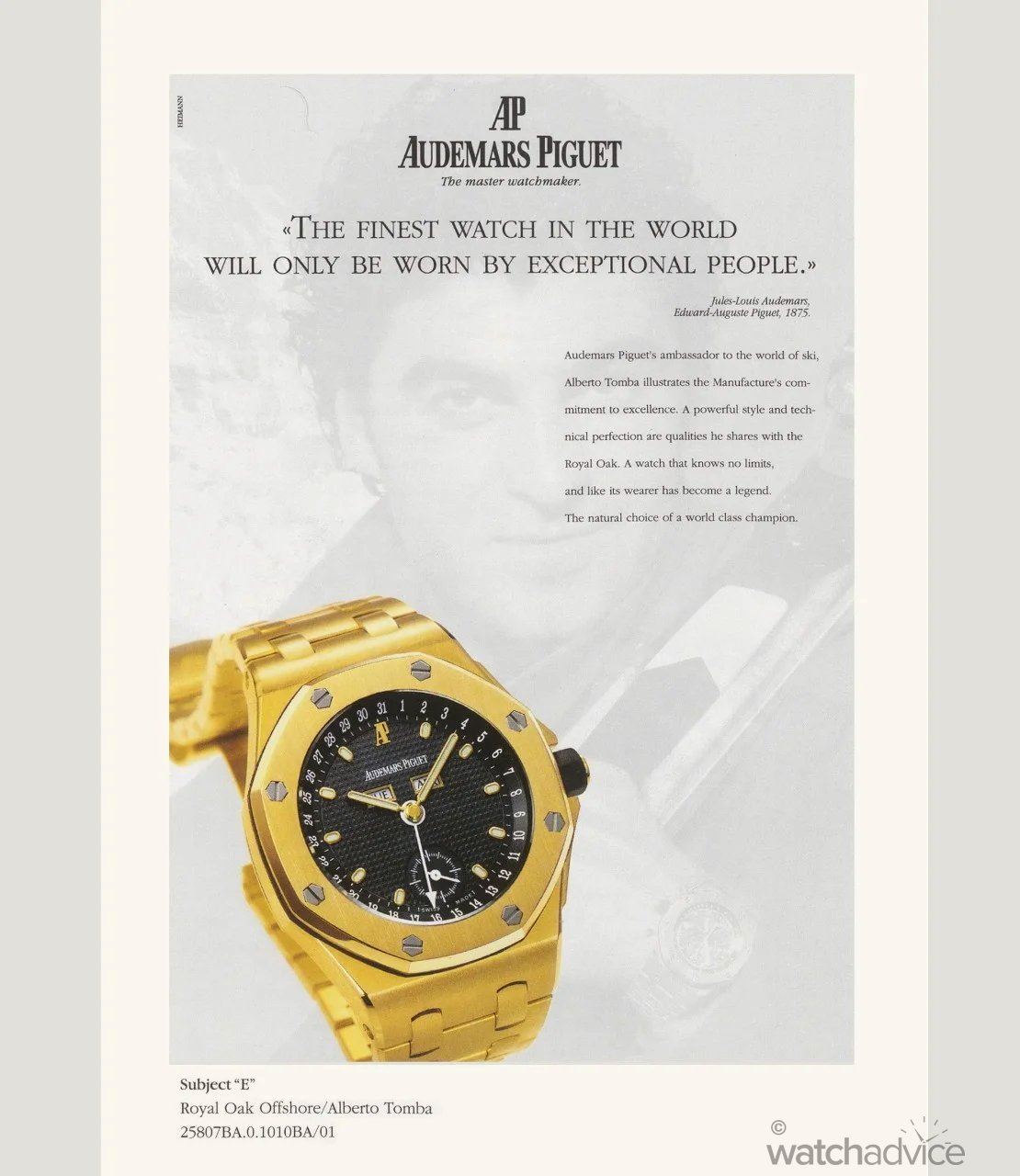
Up until 1996, Audemars Piguet’s only Royal Oak Offshore model was the reference 25721 (42mm). Now, the brand has released a newer version, reference 25808. The timepiece has all the same characteristics as its previous version, such as the oversized gasket, large case thickness (12.05mm), tapisserie dial, and integrated metal bracelet with curved links and studs.
For the first time in the Royal Oak collection, the Royal Oak Offshore Ref.25807 came with a complete calendar complication. The previous version of the Royal Oak Offshore featured a chronograph complication, making it a sportier model. The Royal Oak Offshore Complete Calendar Ref.25807 featured two apertures symmetrically placed at 2 o’clock and 10 o’clock to display the day and the month, while the date is indicated around the dial by means of a dedicated pointer.
1997 – The First Royal Oak Tourbillon watch (Model 25831)
On the 25th anniversary of the Royal Oak, Audemars Piguet decided to release something truly special. While tourbillon timepieces weren’t all that common for the Swiss watchmaker before this, to suit this special occasion, the brand gave the Royal Oak family it’s first tourbillon timepiece with ref.2583, which was powered by the 2875 calibre movement.
Audemars Piguet decided to release only 25 steel models for this 25th-anniversary Royal Oak Tourbillon, which at the time was the world’s most expensive steel watch. The brand also released the first-ever Royal Oak Tourbillon watch in pink gold, platinum, and yellow gold, along with a pink and white gold version. All these precious metal models were limited editions of 5 timepieces each.
1997 – Royal Oak Grande Complication (Ref. 25865)
The endgame of Royal Oak complications came in 1997, during the Royal Oak’s 25th anniversary celebrations. Even to this day, the Royal Oak Grande Complication is the most complex timepiece in the Royal Oak collection (as the name suggests). With its release in 1997, the Royal Oak Grande Complication showcased Audemars Piguet’s leadership in creating modern high-complication timepieces. The Grade Complication ref. 25865 was built by Audemars Piguet Renaud and Papi (known as AP le Locle).
This masterpiece in high horology consists of 648 parts and is finished to such a high level that it requires the manufacture six to eight months to complete one timepiece. As Audemars Piguet states, “To be considered a Grande Complication, a watch must include a minute repeater, a split-seconds chronograph and a perpetual calendar. Since 1882, Audemars Piguet has made a point of keeping the Grande Complication at the spearhead of its production even during times of crisis, perpetuating this ancestral craftsmanship from one generation to the next.”
2002 – Royal Oak Concept Watch CW1


To mark the 30th anniversary of the Royal Oak, Audemars Piguet bought out a new model featuring an all-new design, making it the second Royal Oak variant outside of the original and Royal Oak Offshore models. The Royal Oak Concept was the “futuristic” variant, and as its name suggests, it is a “concept” watch where Audemars Piguet has the freedom to experiment with materials and avante-garde designs.
The Royal Oak Concept CW1 is where Audemars Piguet can showcase their innovation to the world without having to worry about keeping the core design codes of the Royal Oak intact. In saying that, we can still clearly see that the model has Royal Oak heritage with the eight-sided bezel and the tonneau-shaped case.
When Audemars Piguet released the Royal Oak Concept CW1, it came with a completely new alloy for watchmaking. The new alloy, Alacrite 602, has never been used for watchmaking. Alacrite 602 is a cobalt-based super-alloy that has been used almost exclusively in the aerospace and medical industries. The material’s stand-out properties are that it’s incredibly light and strong, making it perfect for watch cases.
2005 – First Openworked Royal Oak Grande Complication Ref. 26065
In 2005, almost a decade after the release of the first Royal Oak Grande Complication, the brand released the first open-worked version of this model. This is a historic moment for the Royal Oak, as the Openworked Royal Oak Grande Complication would become a crowd favourite, even though it is extremely hard to get a hold off.
This timepiece is also hands down one of my favourite Audemars Piguet watches. I love seeing a watch’s technical mastery, and the Royal Oak Grande Complication shows this in all its glory. Reference 26065, when it was released in 2005, was a beautiful display of Audemars Piguet’s capability to create highly technical timepieces while also making them incredibly aesthetically pleasing!
2007 – First Royal Oak in Carbon – Royal Oak Offshore Alinghi Team Forged Carbon
With the Royal Oak Concept Watch CW1 leading the way for materials innovation for Audemars Piguet, the brand was more than comfortable experimenting with different case materials for their Royal Oak timepieces. This led to the first use of forged carbon on a watch in the world of horology. The timepiece was created as a commemoration for the Alinghi Swiss sailing team created by Ernesto Bertarelli, for winning the America’s Cup trophy for the first time in 132 years. While this win was a few years prior to the release of this limited edition Royal Oak Offshore, it still served as the source of inspiration.
The Audemars Piguet Royal Oak Offshore Alinghi Team Limited Edition ref. 26062FS.OO.A002CA.01 was also the first time the brand created the Offshore in a 44mm sized case. The timepiece came with a case and bezel in forged carbon, matched with a black rubber strap. This was also the first time the brand used blackened hex bolts for the screws on the bezel.
2007 – First Royal Oak Concept Watch in Carbon
Following Royal Oak Offshore Alinghi Team Forged Carbon’s success, that same year, Audemars Piguet released the first Royal Oak Concept Watch in the same carbon material. This much more audaciously designed Royal Oak variant now comes with a forged carbon case, with the bezel, crown, and chronograph pushers made from black ceramic!
The Audemars Piguet Royal Oak Concept Carbon, with its technical mastery—the movement features a tourbillon complication, a linear chronograph, a power reserve indicator, and a crown position indicator—now gets the aesthetics updated to meet its technical brilliance.
2012 – Royal Oak 15202
As part of Royal Oak’s 40th anniversary celebrations, Audemars Piguet released several timepieces which commemorate the iconic Royal Oak. One of them being the Royal Oak 15202. This timepiece was originally released in 1999 as a replacement to the 15002.
Rhe 15202ORST (stainless steel) was equipped with dials faithful to the 1972 series A, with the AP monogram at 6 o’clock, Petite Tapisserie motif and Bleu Nuit, Nuage 50 colour. The timepiece also featured Audemars Piguet’s ultra-thin Calibre 2121 movement.
2016 – Royal Oak Concept SuperSonnerie


In 2015, Audemars Piguet released the Royal Oak Concept RD#1, the most sonically concept watch of modern times. The timepiece took eight years to make, with Audemars Piguet being the key sound producer. A year later, in 2016, the brand released the Royal Oak Concept SuperSonnerie, which features a minute repeater with super acoustic intensity.
The timepiece was presented in a titanium case and crafted to make the minute repeater’s acoustic sound the clearest and highest quality in the market by quite some distance. Alongside the minute repeater, the Royal Oak Concept SuperSonnerie also featured a tourbillon and chronograph complications.
2017 – First Ceramic Royal Oak with the Royal Oak Perpetual Calendar Ceramic (Ref. 26579CE)


2017 was another milestone year for the Royal Oak collection as this was the first time a model featured a full ceramic case and bracelet finish. Previously, we have seen Audemars Piguet integrate ceramic into the bezel of the watch, but never a full ceramic finish.
The Royal Oak Perpetual Calendar Ceramic Ref. 26579CE was one of Royal Oak’s most significant achievements, as it combined a highly technical movement with a highly technical material finish. The timepiece came with a black ceramic finish, appealing to a wider audience with its subtle yet beautifully finished look. While this ceramic timepiece certainly wasn’t new to the market, the Royal Oak Perpetual Calendar Ceramic Ref. 26579CE was unlike any other. It presented Audemars Piguet with a unique problem as they had to craft the highly detailed integrated bracelet and tonneau-shaped case with an octagonal bezel in ceramic and polish it to a level that is acceptable for a watch in this calibre.
2018 – Royal Oak Concept Flying Tourbillon GMT
In 2018, Audemars Piguet updated their Royal Oak Concept with a new flying tourbillon complication. The timepiece was presented at the 2018 SIHH fair, and was certainly one of the standout watches. As we have previously seen, the Royal Oak Concept is Audemars Piguet’s playground for experimentation and creating futuristic timepieces with complex mechanisms.
Audemars Piguet first introduced the Royal Oak Concept Tourbillon GMT in 2011, which is the basic foundation of the watch we see here. The flying tourbillon is a different complication altogether, as it is a tourbillon suspended from underneath, creating a floating effect for the complication on the dial. This is a much more complex way of making the already intricate mechanism, resulting in off course a more unique and expensive timepiece.
2019 – The World’s Thinnest Perpetual Calendar

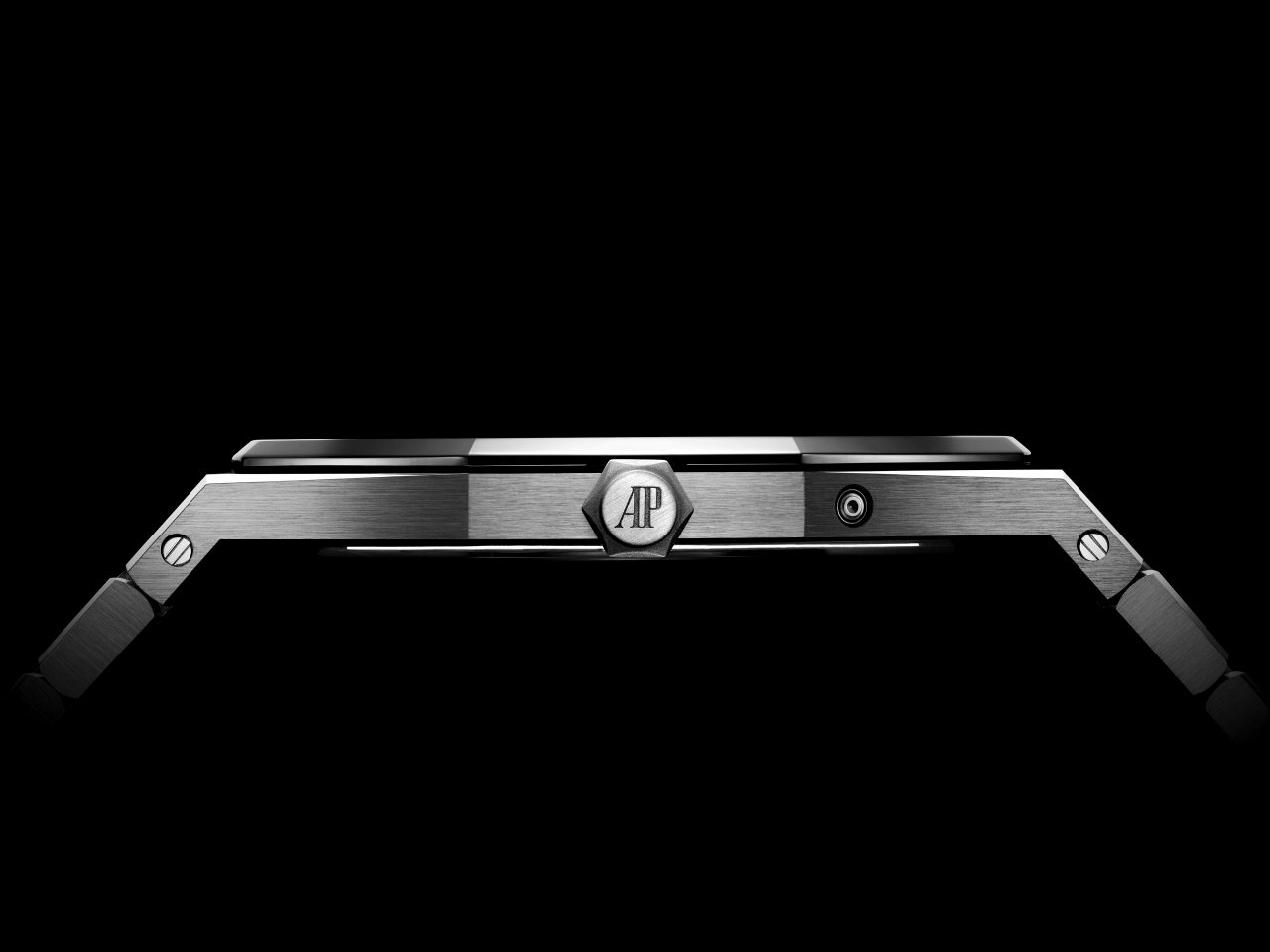
In 2019, Audemars Piguet Royal Oak featured a world first when the brand created the world’s thinnest perpetual calendar wristwatch. This is a ridiculous feat of engineering, as the Royal Oak Perpetual Calendar only measures 6.3mm in height. The brand already has a history of creating thin timepieces, with the movement of the 1921 pocket watch measuring only 1.32mm.
The Royal Oak Selfwinding Perpetual Calendar Ultra-Thin is a true technical marvel and a testament to not only the Royal Oak collection but also Audemars Piguet for constantly pushing the boundaries of what’s possible. Understanadbly, the whole perpetual calendar display and movement from previous Royal Oak editions had to be reconfigured for this timepiece to be able to create a watch so thin!
2022 – 50th Anniversary Edition of Royal Oak “Jumbo”
To celebrate the 50th anniversary of the Royal Oak, Audemars Piguet released a range of timepieces. One of these models was the replacement for the Royal Oak “Jumbo” 15202, released a decade ago. This new Audemars Piguet Royal Oak 16202 “Jumbo” didn’t have too many variations from the 15202, besides a slightly updated dial and all-new movement to suit modern times.
The only major variation noticeable on the watch is actually seen through the case back, where we are treated to the winding rotor being engraved with a special anniversary detail: the “50 years” logo.
2024 – Royal Oak Flying Tourbillon Openworked Sand Gold
Earlier this year, Audemars Piguet unveiled another first for the Royal Oak collection, this time in a brand new material for the watch industry. The Royal Oak Flying Tourbillon Openworked Ref. 26735SG was presented as a world-first crafted in sand gold, a new 18-carat gold alloy that hovers between white and pink gold, beautifully playing with light. Audemars Piguet has also used this sand gold material on the open-worked movement, further re-iterating the beauty of the material.
The Future of Royal Oak
In conclusion, Audemars Piguet’s constant evolution of the Royal Oak stands as a true testament to the brand’s unwavering commitment to furthering craftsmanship skills, innovation, and design excellence. When the Royal Oak was first introduced in 1972, it was a groundbreaking model, pushing aside boundaries set by traditional watchmaking to define what a luxury sports watch can be.
Audemars Piguet’s constant progression of the Royal Oak gave birth to variants of the iconic timepiece such as the Royal Oak Offshore with its controversial yet loved bold and robust design, and the Royal Oak Concept, essentially the brand’s playground for experimentation and creating unique timepieces with futuristic designs. While these timepieces branch out in their own collections, they still honour the original Royal Oak design while being able to embrace contemporary trends and innovation, ensuring that the Royal Oak stays relevant in the modern world of haute horology.
If these past few decades are anything to go by, the journey and legacy of this iconic watch design is far from over. Audemars Piguet promises that there will certainly be exciting new developments that will keep pushing the Royal Oak to new heights and continue to shape the future of watchmaking.



